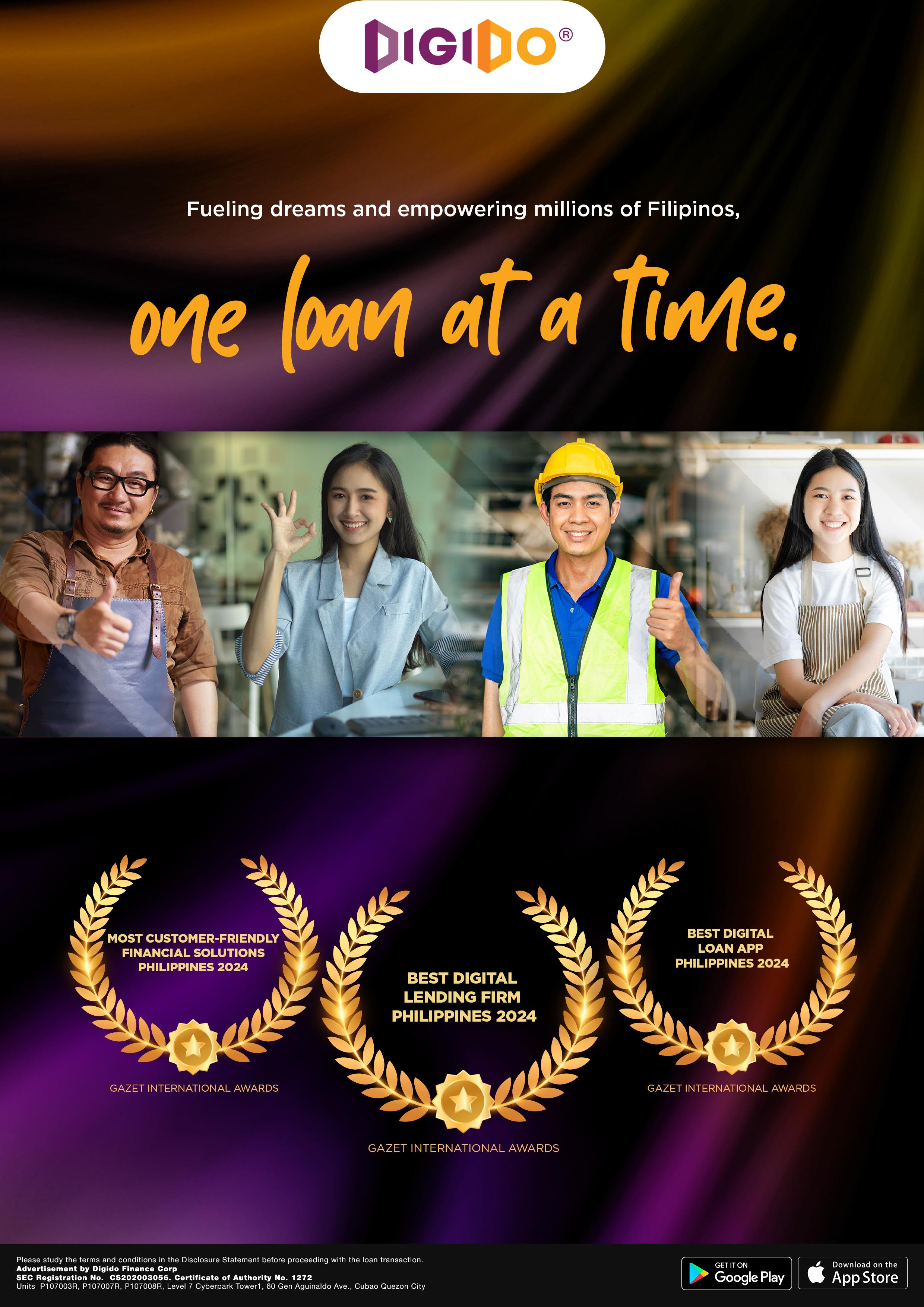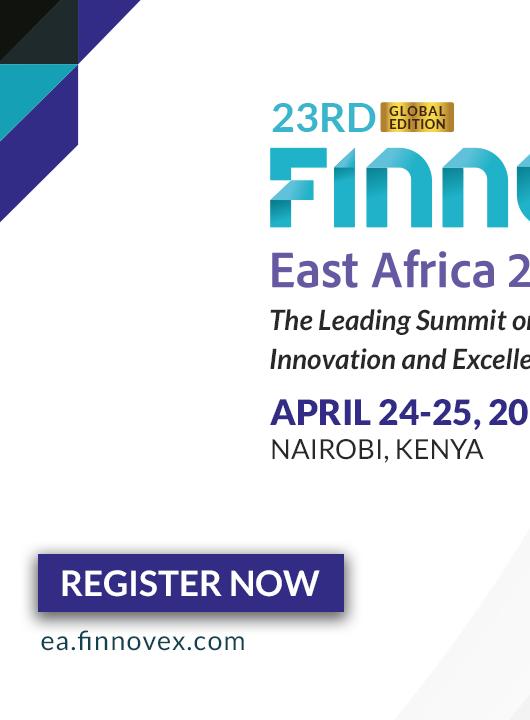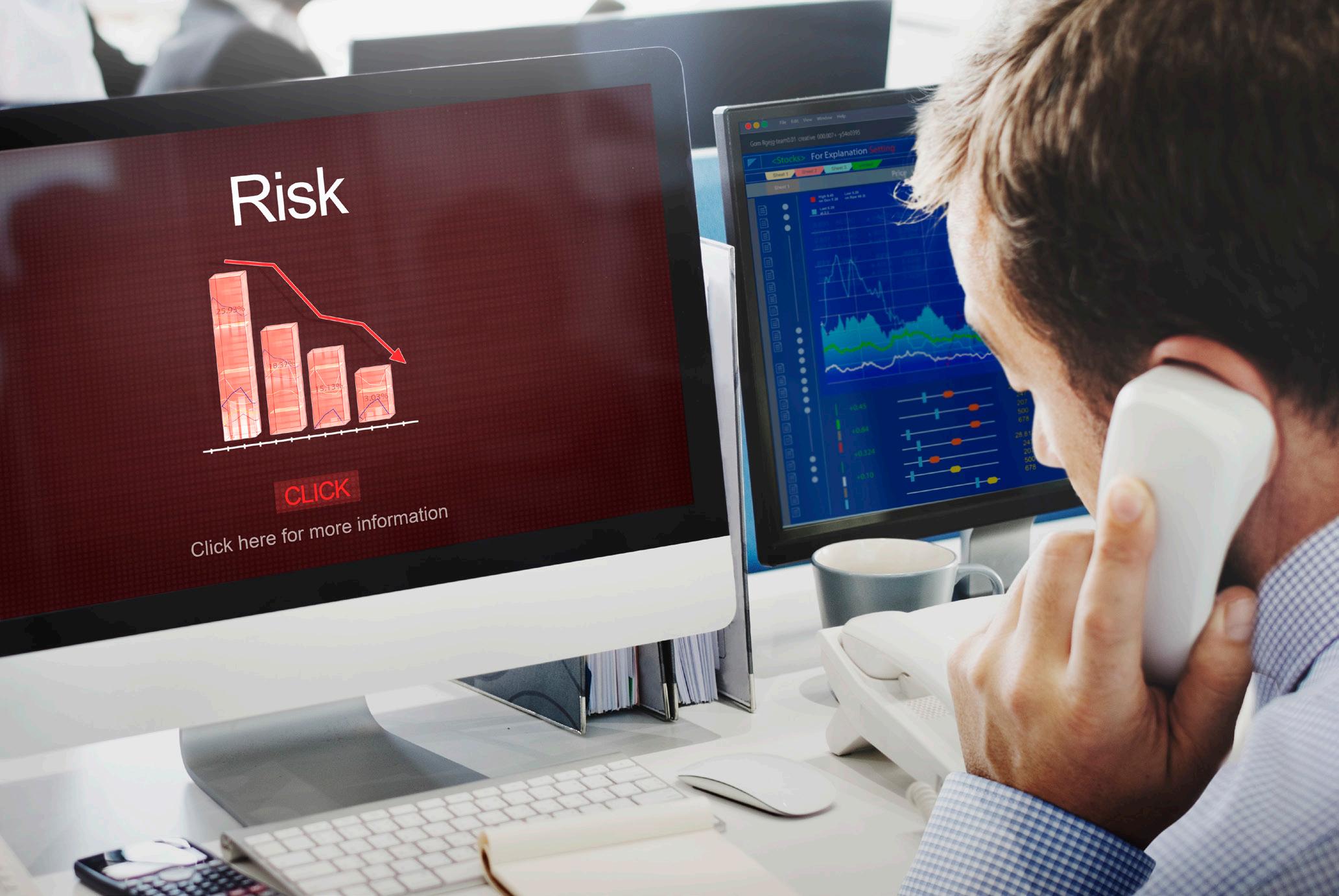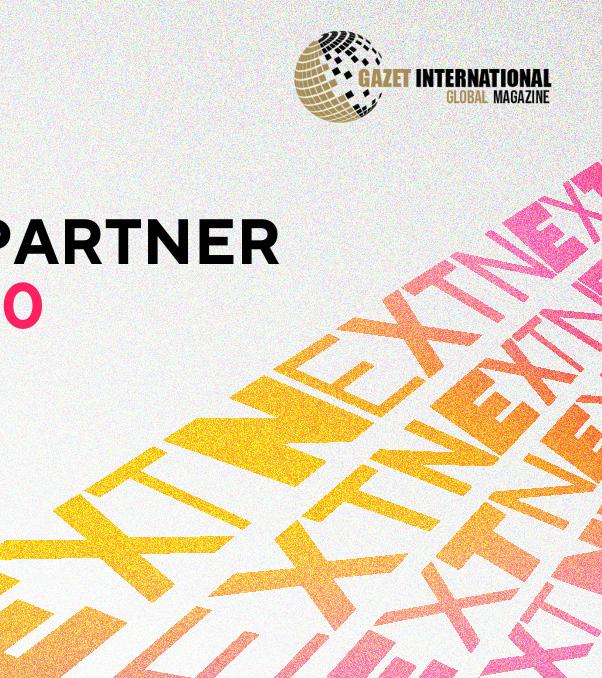

THE FUTURE OF DIGITAL BANKING: AI, CHATBOTS, AND PERSONALIZED FINANCIAL SERVICES
1. Intersection of Tech and Health: Fitness Apps and Wellness Wearables
2. Remote Work Strategies
3. Augmented Reality in Business: Transforming Workplaces and Customer Experiences
www. gazetinternational.com Q1 2024







TABLE 10 16 30 OF CONTENT LIFESTYLE BUSINESS
Intersection of Tech and Health: Fitness Apps and Wellness Wearables
Remote Work Strategies
E-Commerce Trends
Augmented Reality in Business: Transforming Workplaces and Customer Experiences
5G and Beyond: The Evolution of Connectivity
TECHNOLOGY 1.
1.
2.
1.
2.

BANKING
2.


FINANCE AND INVESTING ANALYSIS

44
CORPORATE
1. Sustainable Banking Practices
Financial Inclusion: Bridging the Gap with Innovative Banking Solutions
1. ESG Investing
2. Cryptocurrency Investment Strategies
1. The Future of Digital Banking: AI, Chatbots, and Personalized Financial Services
56 68 74
1. Corporate Learning and Development: Investing in Employee Skills
Editor’s Note
Welcome to the 1st quarterly edition of Gazet International Global Magazine for the year 2024. In this edition, we look into the dynamic landscape of business, technology, finance, banking, lifestyle, and corporate sectors to bring you insightful analyses, trends, and strategies shaping industries worldwide.
In the Business section, we explore the evolving realm of remote work strategies, shedding light on how businesses are adapting to the changing dynamics of the workplace. Additionally, we dissect the latest e-commerce trends driving the digital marketplace forward. Our Technology segment delves into the transformative potential of augmented reality in business operations and the relentless march towards the next generation of connectivity with 5G beyond.

and Investing take center stage with a comprehensive exploration of ESG (Environmental, Social, and Governance) inprinciples, alongside strategic insights into cryptocurrency investment and effective wealth management practices for individthe Banking domain, we scrutinize sustainable banking practices and the imperative of financial inclusion in fostering eqaccess to financial services worldwide.
Lifestyle section intersects technology and health, exploring advancements in tech are revolutionizing the wellness indusempowering individuals to lead healthier lives. Corporate come under the spotlight as we examine the significance of investing in employee skills through corporate learning and development initiatives, essential for staying competitive in today’s fast-paced business environment. Lastly, through our Analysis feapresent a forward-looking analysis of the future of digital banking, offering invaluable insights into the trajectory of finanservices in the digital age.
hope this edition serves as a beacon of knowledge, guiding our through the complexities and opportunities of the global landscape. As always, we remain committed to delivering quality that informs, inspires, and empowers.
regards,
 Suraksha Subba Editor-in-Chief
Suraksha Subba Editor-in-Chief
Gazet International Global Magazine



Intersection of Tech and Health: Fitness Apps and Wellness Wearables
Within the dynamic canvas of modern living, where technology and health seamlessly intertwine, a captivating journey begins—one that enthralls both the mind and body. Picture this: a crisp winter morning, the air filled with the warmth of family and holiday cheer, and nestled amidst the festive wrapping paper, a gleaming beacon of innovation—a health watch. As the vibrant lights of Christmas sparkled around me, this thoughtful gift made me curious about the intersection of technology and health. How can a mere wristwatch work as a guardian of well-being? What stories does it hold within its circuits, and how does it bridge the gap between our digital existence and the vitality of our physical selves? Join me as we embark on an exploration of the symbiotic dance between technology and health, a dynamic interplay that has the power to reshape the way we perceive and nurture our most precious possession—our own health.
This intersection of technology and health is not a mere convergence of two disparate domains; rather, it is a revolutionary symbiosis that has reshaped the landscape of well-being. The health watch, my Christmas gift and newfound companion, serves as a tangible embodiment of this synergy. Beyond its sleek design and intuitive interface lies a realm of data-driven insights into my physical activity, sleep patterns, and overall wellness. It’s a portal connecting me to a world where algorithms decode the intricacies of my well-being, providing personalized feedback and nudges toward healthier choices. From fitness tracking to heart rate monitoring, this amalgamation of cutting-edge technology and health science doesn’t just offer information but it also empowers me to take charge of my own vitality.
Having the privilege of boundless innovation, technology emerges as a steadfast ally in our pursuit of a healthier lifestyle. Fitness apps, acting as virtual coaches, guide us through personalized workout routines, while wellness wearables diligently track our every step, heartbeat, and even the quality of our sleep. These sleek companions, be it smartwatches or discrete sensors, transform our mundane activities into data points, and provide us with valuable insights into our well-being. The latest gadgets go beyond the conventional, seamlessly integrating into our daily lives to encourage healthier habits—reminders to stay hydrated, alerts for sedentary periods, and even stress management techniques. As we immerse ourselves in this digital landscape, the synergy between technology and health becomes evident, empowering individuals to make informed choices and embark on a journey towards holistic well-being.
Together, let us explore the cutting-edge tools shaping the future of well-being. In this article, I will take you into the world of the latest fitness apps that transform our smartphones into personalized fitness coaches, wellness wearables that seamlessly integrate health tracking into our daily attire, and the most innovative gadgets designed to enhance and promote a holistic and healthy lifestyle. From revolutionary workout routines to mindfulness aids, we’ll navigate through the technological landscape that is reshaping the way we approach our health, providing insights and reviews to guide you in making informed choices for your well-being journey. This article is going to be a digital expedition where the synergy of technology and health takes center stage.
https://gazetinternational.com PAGE 9

FItness Apps:
Fitness apps epitomize the intersection of technology and health, using advanced sensors and data analytics to offer personalized workout routines, activity tracking, and nutritional guidance. These apps transform smartphones into accessible and interactive wellness tools, revolutionizing how we approach and engage with our physical well-being.
Future: Future is known to be one of the most notable apps that utilizes technology and content to pair individuals with elite fitness trainers. The users are paired with coaches who help them manage their daily fitness activities and provide them with a personalized training regimen. This cutting-edge health and fitness app is designed to revolutionize your wellness journey. The personalized workout plans, nutrition guidance, and real-time tracking is done with the help of wearables connected to the users’ phones. It can play the role of your ultimate companion for a healthier lifestyle.
Strava: Strava is a popular health and fitness app designed for athletes and fitness enthusiasts. It allows users to track and analyze their physical activities, including running, cycling, and various other workouts. Users can record routes, track performance metrics, and share their achievements with a social community. Strava also features challenges, leaderboards, and the ability to connect with other users, fostering a sense of community and motivation. The app is known for its user-friendly interface and has become a go-to platform for indi-
viduals seeking to enhance their fitness routines and connect with like-minded enthusiasts.
Nike Training Club (NTC): Nike Training Club (NTC) is a health and fitness app developed by Nike. It offers a wide range of workout routines designed for various fitness levels, from beginners to advanced users. The app provides personalized training plans, including strength, endurance, mobility, and yoga exercises. Users can access guided workout videos led by expert trainers, track their progress, and customize workouts based on individual fitness goals. Nike Training Club aims to inspire and motivate users to achieve their fitness objectives through a convenient and user-friendly mobile platform.
Wellness Wearables:
Wearables represent the seamless fusion of technology and health, serving as appreciable manifestations of this intersection. These devices, encompassing smartwatches, fitness trackers, and health-monitoring wearables, leverage advanced sensors and connectivity to monitor and analyze various aspects of our well-being. By constantly collecting and processing data on physical activities, vital signs, and sleep patterns, wearables empower individuals with real-time insights into their health. This integration of technology not only enhances personal awareness but also promotes proactive and informed decision-making, marking a transformative shift in how we engage with our own wellness.
GAZET INTERNATIONAL MAGAZINE LIFESTYLE PAGE 10
Fitbit Luxe: The Fitbit Luxe is a sleek and stylish fitness tracker that combines fashion with functionality. Designed to seamlessly integrate into daily life, this slim and lightweight device offers a range of health and wellness features. The Luxe provides 24/7 heart rate tracking, sleep monitoring, and stress management tools to help users maintain a holistic view of their well-being. With a vibrant AMOLED display and customizable watch faces, it not only keeps users connected with call and message notifications but also adds a touch of personalization. The Fitbit Luxe is an ideal companion for those seeking a balance between fashion-forward design and comprehensive fitness tracking.
Garmin Vivomove Trend: The Garmin Vivomove Trend is yet another stylish and functional hybrid smartwatch that seamlessly blends classic design with modern technology. While it has a traditional analog watch face, the Vivomove Trend disguises smart features beneath its elegant exterior. The watch incorporates fitness and health tracking capabilities, monitoring steps, heart rate, and stress levels. Equipped with a hidden touchscreen display, users can access notifications, health metrics, and other smart functionalities without compromising the classic watch aesthetics. The Vivomove Trend offers a comprehensive suite of fitness features, including sleep tracking and Body Battery energy monitoring. The watch boasts a durable build, water resistance, and long battery life, ensuring it can keep up with everyday demands of the users. With its versatile design and advanced features, the Garmin Vivomove Trend appeals to those seeking a blend of timeless style and modern functionality in a smartwatch.
Oura Ring Gen3: The Oura Ring Gen3 is the latest iteration of the innovative health and wellness wearable. This sleek and stylish ring is designed to provide comprehensive insights into one’s overall health by monitoring key biometric data. With advanced sensors, the Oura Ring Gen3 tracks sleep patterns, activity levels, and physiological signals, offering users a holistic view of their well-being.Equipped with state-of-the-art technology, the Gen3 boasts improved accuracy and enhanced features, making it a valuable tool for individuals seeking to optimize their health. The ring seamlessly integrates with a dedicated app, allowing users to access personalized recommendations based on their individual health data. Its compact and comfortable design ensures that wearers can effortlessly incorporate the Oura Ring into their daily routines. From sleep quality assessments to activity tracking, the Oura Ring Gen3 empowers users to make informed lifestyle choices to support their overall health and performance. This next-generation wearable represents a cutting-edge approach to holistic well-being, emphasizing the importance of data-driven insights in fostering a healthier and more balanced lifestyle.
Apollo Neuro: Unlike the wearables mentioned above, Apollo Neuro is not a watch, but a wearable device that comes across as a small circular disc. Users can wear it on their ankles or
wrists as it does not serve as a timekeeping device. It is a wearable device designed to enhance well-being by leveraging neurotechnology. Developed by Apollo Neuroscience, the device utilizes gentle vibrations to stimulate the body’s natural calming mechanisms, promoting relaxation and stress reduction. Apollo Neuro aims to address various aspects of mental and physical health, including sleep quality, focus, and overall resilience. By influencing the autonomic nervous system, it seeks to provide users with a non-invasive, drug-free solution for managing stress and improving overall mental well-being. The device can be worn discreetly and controlled through a mobile app, making it a convenient tool for individuals looking to integrate technology into their wellness routines.
With the rise of health apps and wearables we have the privilege to start our transformative journey toward personalized and proactive healthcare. These technological companions have empowered us to take charge of our well-being, providing real-time insights and fostering a holistic approach to health. As we embrace the convenience of tracking our steps, monitoring vital signs, and accessing personalized fitness routines, it becomes clear that the intersection between technology and health is not just a trend but a revolution. The future promises even more innovative solutions, promising a world where health is not just a destination but a continuous, personalized journey guided by the seamless integration of apps and wearables into our daily lives.

https://gazetinternational.com PAGE 11



REMOTE WORK STRATEGIES

STRATEGIES


When the Covid-19 pandemic struck in December 2019, our reality was profoundly shaken. This widespread illness led to significant societal disruptions, altering our daily life activities. We were compelled to modify our way of living as it affected our work conditions, economy, education, social life, health, and essentially everything. Just like that, remote work transformed from being a privilege to the standard practice, as we had no option but to abandon traditional office settings for global workforce operations. By 2021, we had already witnessed noteworthy technological advancements, such as video conferencing platforms, collaboration tools, cloud computing, and e-learning. These advancements not only supported remote working but also had a large-scale influence on the evolution of work models, as many organizations continue to embrace flexible and remote work arrangements. This shift prompted us to reevaluate our perspectives on remote working, giving us the opportunity to recognize its viability and incorporate it as a long-term strategy.
To address the challenges posed by Covid-19, we had to adapt our operations to accommodate remote work. Common strategies included the adoption of digital collaboration tools, utilization of cloud-based technologies, implementation of flexible work policies, utilization of outcome-based performance metrics, and more. Now, let’s delve into these strategies that
companies worldwide have implemented.
Digital collaboration tools are software applications and online platforms that facilitate online communication, collaboration, coordination and teamwork in remote or distributed work environments. By leveraging digital technology, it allows us to collaborate, share information and manage projects remotely. Video conferencing platforms like Zoom, Google Meet and Microsoft Teams allowed companies to conduct virtual meetings, video conferences and webinars. Regardless of users’ physical locations, these platforms include features like screen sharing, chats and file sharing enabling real-time collaborations and events. It is a medium of connecting in a visually interactive environment. Virtual whiteboards like Miro and Microsoft Whiteboard resemble traditional whiteboards.
Virtual teams can utilize these tools to brainstorm, diagram and plan with added features like sticky notes and drawing tools. Project Management Software is digital tools like Asana or Trello that help teams organize tasks, set priorities, and track project progress efficiently. These platforms often include features for task assignment, timelines, and document sharing to streamline project coordination. Document collaboration tools, like Google Workspace and Microsoft 365, facilitate real-time collaboration on documents, spreadsheets, and presentations. By enabling multiple users to edit and comment
GAZET INTERNATIONAL MAGAZINE BUSINESS PAGE 16

on files simultaneously, these tools enhance teamwork and efficiency in document-centric tasks. Other digital collaboration tools are instant messaging and chat apps (Telegram, Slack), file sharing and storage (Dropbox, OneDrive) and task automation tools (Zapier, IFTTT).
Cloud-based technologies are computing services, applications, and resources that are delivered over the internet through cloud computing infrastructure. Instead of relying on local servers or personal devices to store and manage data, cloud-based technologies benefit from remote servers hosted by third-party providers. These servers are part of vast data centers that offer a range of services accessible to users over the internet. Remote data storage is one of the main reasons why businesses rely on cloud services, as they allow users to store and access data remotely. This dismisses the need for physical storage devices and provides users with scalable and flexible storage solutions. Users can also access computing resources, such as processing power, storage, and databases, on a pay-asyou-go basis. This flexibility is a huge advantage to organizations as they can scale their infrastructure based on demand. Cloud-based services are also accessible from any device given that users have an internet connection. This accessibility facilitates remote work and collaboration among users in different locations.
Remote access infrastructure plays a crucial role in facilitating remote work by providing secure and seamless access to company networks, systems, and data from various locations. Typically implemented through Virtual Private Networks (VPNs), remote access infrastructure ensures a secure and encrypted connection between remote devices (such as laptops or home computers) and the company’s network. This also protects the company’s sensitive data and communications from unauthorized access. There is higher security as there are authentication and authorization mechanisms to ensure that the access to the company’s resources is only granted to authorized personnel. Remote access infrastructure is also configured to comply with data security regulations and standards. This assures that remote work processes adhere to legal and industry-specific requirements regarding the protection and privacy of sensitive information.
Flexible work policies provide employees with a framework that empowers them to balance their professional responsibilities with their personal needs and preferences. These policies contribute to employees’ work-life balance, allowing them to modify their work hours in alignment with their personal commitments. When employees are given the choice to determine their work hours, their stress is substantially reduced, promoting overall well-being. By allowing employees to choose their work location, they can tailor their work en-
https://gazetinternational.com PAGE 17

vironment according to their preferences, enhancing productivity and comfort. With reduced commuting time and stress, flexible work policies also contribute to employees’ energy levels. Through flexible work policies and remote work options, organizations can tap into a more diverse and global talent pool. Employees from different locations can contribute to the organization’s success across various time zones. Flexible work policies grant employees the autonomy to choose their work location and hours, directly contributing to job satisfaction and fostering a culture of trust.
Outcome-based performance metrics support remote work environments as the employees’ results and contributions are used to measure their performances. In this strategy, the traditional method of measuring work hours that employees put into work or spend in the office are discarded. When this is implemented, employees focus on delivering meaningful outcomes. Knowing that their performance is not judged solely on work hours, employees can manage their time effectively, adapting their work to peak productivity hours. It gives them ownership over their tasks and projects, encouraging a sense of responsibility and accountability. With the help of clear communication, goal setting and collaboration, outcome-based
performance metrics ensure that employees directly contribute to the organization’s success.
In remote onboarding, new employees are integrated into the organization through virtual means. To ensure a smooth transition, training, orientation and virtual access to resources are provided to employees online. With limited physical presence and face-to-face interactions, the transition process goes smoothly as employees’ performance judgments are not biased based on their appearance. It is also easier to build relations with the team members, managers and the stakeholders through virtual platforms. With proper remote support systems, adaptability training and feedback mechanisms, remote onboarding aids in building resilient and adaptable workforce.
Employee training and support guarantees that employees possess the required skills, knowledge and resources for successful remote work. To promote technology proficiency among employees, training should focus on using remote collaboration tools, video conferencing platforms, project management softwares and other digital tools. Support for technical issues allows them to troubleshoot problems and use remote work technology with ease. The changes are nev-
GAZET INTERNATIONAL MAGAZINE BUSINESS PAGE 18

er ending in today’s work culture. Timely training in terms of work processes, technologies and organizational policies play a vital role in helping them adapt to changes. Employees in managerial positions should provide guidance and assistance during such transitions so that the employees can successfully navigate changes and challenges while working remotely. Continuous opportunities for skill development and career advancement empowers the workforce to navigate the challenges of remote work. This fundamentally contributes to building a positive and productive remote work culture within the organization.
While the adoption of these strategies introduced flexible and technology enabled work models, the transition process varied for different businesses and industries. Businesses that depended on in-person interactions or had little to no experiences with remote working faced various challenges.
One of the biggest challenges was technology adoption among
employees. It was quite a feat getting employees accustomed to new collaborative tools as they require time and training. Additionally, businesses also had to go through infrastructure readjustments having to adapt their IT infrastructure to ensure secure access to company systems and manage potential cybersecurity risks. Many companies also struggled to sustain effective communication and connection among remote teams. Employees who were new to remote work, as a previously unexplored workforce strategy, reported difficulties in managing stress, isolation and conserving work-life balance.
These challenges highlight the importance of flexibility and agility required to adapt in time of unforeseen disruptions. Let us look into some of the strategies that businesses and industries can implement to address the challenges mentioned above. Granted that Covid-19 has evolved since 2019, the implementation of these strategies can help companies prepare for unexpected events that might take place in the near future, Successful implementation of remote work involves a com-
https://gazetinternational.com PAGE 19

bination of strategic planning, effective communication and steady support to the employees.
With respect to technology readiness, businesses and industries need to invest in user-friendly collaboration tools and provide training to employees until they achieve proficiency. Timely training should be provided with each update and upgrades. Infrastructure adjustments such as implementation of Virtual Private Networks (VPNs) and multi-factor authentication are necessary to secure remote access solutions to protect data and systems. Cyber Security training is another essential component for smooth remote work as employees need education about potential risks and practices to maintain security.
Communication strategies are a focal point that businesses and industries should not miss if they want smooth remote work. Both synchronous and asynchronous methods of communication can be mixed to foster open and transparent communication. For real-time interaction, employees can communicate through phone calls, video conferencing and chats. In other cases, employees can depend on asynchronous methods like emails, forums, social media posts and project management
tools. Synchronous methods of communication can be of disservice if participants are not available simultaneously, especially because of varying time-zones and schedules. On the other hand, asynchronous methods of communication can disadvantage participants because of slowed response times, miscommunication due to delays and lack of immediate feedback. Therefore, when making a voice between these two methods, factors like the nature of communication, needs of the participants and goals of the interaction should be thought through. To stimulate the sense of connection among remote teams, team leaders can also organize routine virtual meetings and team-building activities. Some examples of team-building activities are virtual icebreakers, online trivia night, themed virtual lunches, and online wellness challenges. However, these activities should be tailored according to the members’ preferences and comfort levels. When we implement these activities, we are building camaraderie and fostering a sense of teamwork that can strengthen bonds and promote collaboration.
Businesses and industries that are planning to enforce remote work need to embrace changes in policies, practices and com-
GAZET INTERNATIONAL MAGAZINE BUSINESS PAGE 20
munication styles. Apart from outcome-based performance metrics and virtual collaboration tools that I have already discussed previously, there are various other cultural shifts that can be implemented to assist a remote-friendly environment. Before agreeing upon parameters regarding flexible work hours, clear communication guidelines should be established. With the help of these guidelines, organizations make their expectations clear while communicating their commitment to flexibility. To endorse best practices for remote work, training programs linked to time management, setting boundaries and effective communication can be offered to employees. Mechanisms to appreciate and recognize employees and their efforts should also be established as they boost employee morale and motivation. This can be done through virtual shoutouts, awards and recognition programs. As remote employees could come from different geographical regions, businesses and industries need to embrace diversity and inclusion. They should be included in company activities and decision making processes as this promotes equality and makes employees feel valued. Forming Employee Resource Groups (ESGs) based on various dimensions of diversity like ethnicity, gender, sexual orientation and ability provides employees with networking opportunities and a platform for advocacy within the organization. Other measures that can be taken to promote diversity and inclusion are reviewing pay equity, celebrating diversity, promoting diverse leadership representation and providing diversity training.
Fast forward to 2019, and the global workforce has undergone a tremendous transformation with the widespread adoption of remote work. Taking this paradigm into account, we have explored numerous strategies and challenges for businesses and industries looking to implement remote work. There is no doubt that the holistic approach discussed in this article will help them navigate this frontier successfully. By placing equal emphasis on technology and human aspects, and implementing clear communication channels, we must not overlook the crucial topics of work-life balance and flexible policies. This article serves as a tool to build resilience and adaptability crucial attributes for both organizations and individuals. This conclusion serves as a reminder for leaders and organizations to remain agile, consistently reevaluate their strategies, and leverage technology to its fullest potential. If we strategize and empathize accurately, we can surely bring about a revolution in the global workforce, surpassing the productivity of traditional workplaces.

https://gazetinternational.com PAGE 21
E-Commerce Trends

From buying groceries to sending orchids to my mother every year on her birthday, online shopping has been a life saver for me since the last couple of years. Online shopping, also known as ‘E-commerce,’ refers to buying and selling of products and services over the internet. Through online transactions, e-commerce is a common form of trading that takes place between Business-to-Consumers (B2C), Business-to-Business (B2B) and Consumers-to-Consumers (C2C).
While our perspective of e-commerce is limited to current experiences, the early concepts of e-commerce were actually introduced between the 1960s-1980s. Electronic Data Interchange (EDI) was developed by Ed Guilbert in the 1960s to mediate electronic communication for shipping of supply chains in the US Army. EDI was then adopted by businesses to exchange electronic documents related to purchase orders and invoices. While EDI was only limited to large corporations at that time, the World Wide Web changed e-commerce again in the 1990s. Businesses began utilizing it to share information about themselves. Further developments of secure online payment methods and reliable internet connections gave platform for the development of online retail pioneers like Amazon and eBay. Then came the dot-com boom in the late 1990s, marked by the emergence of online retailers and marketplaces. However, its crash in the early 2000s led to the closure of many
internet based companies. Between 2000s to 2010s, there was advancement of smartphones and in no time it became accessible to a wide population worldwide. Due to this, the world witnessed the expansion of e-commerce in the mobile realm. Mobile commerce (m-commerce) and development of related apps and websites allowed consumers to make purchases online through their mobile devices. Today, businesses have it easier as they can rely on platforms like Magento and Shopify to manage their online stores. Apart from Amazon and eBay, today we have platforms like Etsy and Alibaba and much more to shop from. These marketplaces are platforms that businesses can utilize to reach a broader audience worldwide.
E-commerce today is made up of various components. We can easily access online storefronts through websites and applications to buy products and services that have been displayed by businesses. This also allows us to compare prices of similar products or services being displayed by competing brands. Well established retail platforms facilitate transactions through payment gateways. Consumers can also choose the option of cash-on-delivery (COD) while shopping online. Online shopping carts allow consumers to add numerous products in the virtual shopping carts at once before finishing their purchase. Logistics and fulfillment is another key component of e-commerce which manages inventory, order-processing and deliv-
GAZET INTERNATIONAL MAGAZINE BUSINESS PAGE 22
ery. Lastly, we have security measures like encryption and authentication to ensure safe online transactions.
With the evolution of e-commerce, we are being introduced to numerous notable emerging technologies which will certainly shape the future of ecommerce. These technologies aid with enhanced user experience, improved operational efficiency and provides innovative solutions to businesses.
Artificial Intelligence (AI) and Machine Learning (ML) have taken over numerous industries by storm and ecommerce is undoubtedly one of them. More and more ecommerce companies are integrating AI tools to aid their workflow and marketing strategies. AI tools that collect and analyze real-time data about consumers’ browsing habits and purchase histories help businesses with targeted advertising, increasing their marketing effectiveness. AI tools also offer enhanced operational efficiency as it allows companies to automate repetitive tasks and analyze large amounts of data within a short period of time. This not only reduces the required time and human resource, but it also reduces operational costs significantly. Many companies have invested in ML to have a better understanding about their clients. With that understanding, they can personalize product recommendations for their clients and enhance the customer experience. ML also allows dynamic pricing as its algorithm can detect new demands and trends among consumers. Amazon, the pioneer of ecommerce, has adopted ML for dynamic pricing. ML’s predictive model allows Amazon to determine the best price for each product and display real-time discounts to the consumers. Compared to Walmart and BestBuy, Amazon changes their prices every 10 minutes, accounting for a 25% increase in their profits. AI-powered chatbots have also been prevalent these days as they provide timely customer service, answer FAQs, automate sales, and gather feedback and data from customers. As they are available 24/7, this eases the work of human customer service representatives. The post-sale support offered by AI helps in fostering long-term trust and loyalty among customers. Ecommerce platforms can utilize AI driven chatbots, rule-based chatbots and hybrid chatbots based on their needs.
Augmented Reality (AR) and Virtual Reality (VR) have been
introduced as a crucial technology for bridging the gaps between the digital and physical world. Their interactive nature has made the shopping experience for consumers increasingly meaningful and personalized. They have driven and shaped the experiential marketing by engaging their mobile and virtual sense. They amplify the storytelling efforts of brands as consumers can interact and get immersed with the content on a deeper level. With virtual try-ons, shoppers can save the time spent on visiting malls and buy products with more convenience. As AR and VR allows consumers to ‘feel’ the product virtually, this can significantly reduce the return rates and operational costs.
Blockchain technology has definitely helped the ecommerce industry overcome long-term and short-term challenges. This digital ledger has streamlined the record-keeping process and promoted transparency with regards to payments, orders and shipments. It facilitates decentralization, authenticity, traceability and scalability. Built from Distributed Ledger Technology (DLT), blockchain is known for providing a heightened level of data security for ecommerce platforms. The transactions recorded in the shared ledger ensures traceability and accountability of transactions. This also reduces the risk of fraudulent products, ensuring authenticity of products. Adopting blockchain also reduces the need for intermediaries as smart contracts automated by blockchain automates and reinforces agreements.
From agriculture to telecommunications, the Internet of Things (IoT) has revolutionized a wide range of industries. The ecommerce industry is no exception. IoT allows retailers to create smart online stores by deploying IoT enabled cameras and sensor-based devices. Features like smart inventory management, and real-time tracking of products can be enabled with the help of IoT devices. Equipping smart stores with RFID tags, smart carts and shelves, and automated checkout systems allow consumers to experience informed and convenient shopping. Digital connectivity allowed by IoT allows retailers to identify active zones through heat maps. This helps them in planning store layout and deciding displays of discounted and popular items. Apart from this, IoT plays a dominant role in personalizing customer experience, automated checkout lines,

https://gazetinternational.com PAGE 23

and product tracking.
Data security breach is one of the biggest challenges in the ecommerce industry. Biometrics authentication plays a powerful role in combating this challenge and shaping the future of ecommerce. Unlike traditional methods of using username, email id and password, ecommerce can use biometrics of users for login and payment purposes as they cannot be replicated or stolen by cybercriminals. Unique traits like fingerprints, facial scans and vein recognition mitigates the risk posed by guessable passwords. Biometric authentication not only protects users from cybercrime but it also facilitates seamless checkout experience making their overall shopping experience secure and convenient.
Robotics and automation is transforming the realm of ecommerce through its effects on business operations and customer experience. Warehouse automation can be done by deploying robots for the purpose of order picking, packing and sorting. Deploying robots in warehouses can help save time as they navigate shelves, fetch items and pack orders promptly. Chatbots can be used to handle inquiries related to product information and order status updates. AI and ML automation can be leveraged to analyze and maintain customer data to predict changes in demand patterns. This is also practical for inventory planning to ensure that products are available during peak demands. Robotics and automation have also been game changers for last-mile delivery. It is a transformative solution
for customer satisfaction. Through automation tools, we can replace manual route planning which is generally inefficient and prone to errors. With the help of route optimization software and GPS tracking systems, we can analyze real-time data to avoid traffic and construction disturbances, and choose the easiest delivery routes. Integrating technologies like robotic arms, conveyor vehicles and automated guided vehicles (AGVs) in warehouses enhances the attention required for lastmile deliveries. When ecommerce businesses utilize drones and sidewalk bots, they can avoid delays in delivery caused due to congestion, lack of parking and incorrect customer addresses. With more advancement in autonomous vehicles and robots, businesses will not only be reducing their operational costs, but they will also be taking a step toward sustainability by reducing emissions currently being caused through traditional delivery methods.
These emerging technologies in ecommerce are playing a huge role in changing consumer behavior. It is impacting conversion rates and the decision-making of consumers through convenience, efficiency and experience.
Through personalization enabled by AI, the product recommendation can enhance the user’s overall shopping experience. AI chatbots and virtual assistants can also improve customer engagement. Smart speakers like Amazon Alexa and Google Assistant, allow users to make purchases using voice commands. This completely changes the way they search for
GAZET INTERNATIONAL MAGAZINE BUSINESS PAGE
24

products and make transactions. Using predictive modeling in subscription services, ecommerce businesses can suggest personalized subscription services according to their preferences. Subscription based ecommerce models seem to be changing the manner customers buy products in the food, beauty and apparel industry.
In the fashion and home decor industries, AR and VR has been making the decision making process easier for consumers. The 5G technology is also contributing to positive customer experience by reducing the time websites and apps take time to load. Faster and reliable internet connection allows customers to shop and pay online seamlessly.
Social commerce refers to the integration of ecommerce features in social media platforms. Social media platforms like Facebook, Instagram, and Pinterest have integrated these features allowing businesses to create digital storefronts within the platform itself. This allows social media users to discover products while scrolling through their feed and purchase it without having to leave the platform. Through social commerce businesses can reach a wider audience as users can discover brands through their friends’ posts. It is also easier to convert customers as it eliminates the need to switch apps or websites and customers can easily see reviews from other customers. Users can also save the products they wish to buy later. Social media influencers also play a major role in promoting businesses and generating conversions. With their huge num-
ber of followers, they can easily influence their audience’s buying behavior by recommending products or advertising for them. They also play a pivotal role in building brand awareness by driving traffic to the brands’ websites.
These emerging technologies are not only about fostering convenient and interactive shopping experiences for customers. They are also equally important in empowering customers by providing them with information, choices and a sense of control. However, it is also imperative that we look into the impact of global events on the ecommerce industry. Global events and their nature, scale and duration can have a huge impact on the ecommerce industry, both positive and negative. Let’s look into some of the common impacts that global events can have on the ecommerce industry.
Global events like pandemics, economic downturns and geopolitical events can lead to changes in spending patterns of consumers. During such events, consumers focus on purchasing goods that they need rather than goods that they want. They prioritize essential goods that fall under their budget which impacts online sellers who sell nonessential goods. Taking the Covid-19 pandemic as an example, it is also evident that periods of restrictions can change consumers’ preferences. During periods of restrictions and uncertainty, it is plausible for people to opt for online shopping and delivery options for safety and convenience purposes. During a recession, consumers will not only reduce their purchasing and spend less
https://gazetinternational.com PAGE 25

on nonessentials, but they may also switch to cheaper brands and buy products only when they can sense product advantage. Geopolitical events can influence consumer sentiments, often leading them to boycott certain products. For example, because of the ongoing Israel Hamas conflict, Starbucks has been boycotted in many countries due to Howard Schultz, who is not only its largest private shareholder, but also an active Zionist. Apart from decreased revenue, few Starbucks outlets also got vandalized. Similarly, many other companies have been boycotted for supporting Israeli policies. This was done by the supporters of Palestine and to display solidarity with the Palestinian people in the ongoing Israel Palestine conflict. Geopolitics can also affect consumer behavior as it triggers most market volatility and commodity prices.
Global events like natural disasters, shifts in geopolitical landscape and trade disruptions can exert influence on the supply chain. Currently, due to the Israel Hamas conflict, Houthis from Yemen have been hijacking the ships in the Red Sea to demonstrate their support toward the Palestinians. Leading to major shipping disruptions, the Red Sea crisis has affected global commerce and logistics. The commercial vessels being hijacked have disturbed the trade between Europe and Asia.
Moreover, the new trade route suggests that the vessels move around the Cape of Good Hope, which adds an extra two weeks journey and unnecessary expenses. This is an example of how shifts in the geopolitical landscape have affected 11% of global trade that takes place through the Red Sea. Natural disasters can also cause delayed delivery and increase in costs. Infrastructures and facilities can get damaged and it may take years for businesses to recover. Logistical challenges and shortage of goods in ecommerce platforms due to global events can influence consumer choices and trust in online shopping.
The Covid-19 pandemic mandated safety measures like social distancing and lockdows which led to global digital transformation acceleration. This influenced people who were previously hesitant to shop online adopt ecommerce out of necessity. We can consider the pandemic as an example of a global event which resulted in broader acceptance of digital platforms for shopping.
Global events can also bring about changes in product demand. Conflicts and pandemics can change consumer priorities and lifestyle, increasing demand for certain product categories like health-related products. Another example can
GAZET INTERNATIONAL MAGAZINE BUSINESS PAGE 26

be the widespread adoption of remote work strategies which generated demands for home-office equipment.
Changes in international trade policy agreements and tariffs can also affect the prices and availability of imported goods and availability of imported goods. Higher tariffs can lead to supply chain disruptions as businesses will be compelled to consider suppliers and regions to reduce tariff related costs. Trade tariffs and policies can directly affect export demands. Increase in import tariffs can result in lesser demand for imported goods, influencing demand for domestic products. Online retailers need to come up with strategies related to product offerings and prices during such changes. Diplomatic relations have now allowed cross-border payments. This has changed the ecommerce realm by boosting consumer’s confidence in cross-border shopping.
Cybercriminals are often waiting for a chance to exploit crises like pandemics and wars. They often create fake business or fundraising websites and emails that look legitimate. Through these websites and mails they conduct activities like identity theft and gain access to user’s financial resources. Increased fraud, phishing attempts and cybersecurity threats during vulnerable times can diminish consumer trust in online shopping platforms. Cybercrimes like supply chain attacks can also affect ecommerce sellers if they have a weak organization ecosystem.
Ecommerce businesses should regularly ensure that their marketing and communication strategies are aligned with the ongoing global contexts. During challenging times, brands need to craft their messages with their consumers. When it comes to sensitive and controversial topics, brands need to be careful with their reaction. It is not always necessary to react to each and every global event, if they cannot humanize their promotional contents. Timeliness does contribute to brand exposure, but if they exploit global events using insensitive contents, they may lose their reputation in the long run.
In conclusion, the ever-evolving landscape of e-commerce continues to shape and be shaped by current trends, enormously influencing consumer behaviors in unmatched ways. As we navigate through this digital era, it is evident that the integration of emerging technologies, personalized experiences, and sustainable practices are key drivers of success for online businesses. Furthermore, the profound impact of global events on e-commerce highlights the industry’s resilience and adaptability. From the challenges posed by a pandemic to the opportunities born out of shifting consumer preferences, the e-commerce ecosystem remains dynamic and responsive. As we move forward, businesses that embrace these trends, understand changing consumer needs, and navigate the complexities of global events will position themselves for sustained success in the ever-growing and evolving world of e-commerce.
https://gazetinternational.com PAGE 27
Augmented Reality in Business: Trans forming Workplaces and Customer Experiences
When L’Oréal acquired ModiFace in 2018, the world of fashion and beauty industry experienced a tremendous breakthrough. This digital transformation introduced the game changing concept of Augmented Reality (AR) to the beauty industry, and the rest is history. AR is a technology known for its interactive experience generated through the combination of the real world and computer-generated elements. Do not confuse AR with VR - Virtual Reality, as AR enhances our perception and interaction within the physical world. VR, on the other hand, is entirely immersed in the digital environment. In this article, we will explore the scope of AR in businesses.
Some of the most common ways to use AR are through smartphones, tablets, smart glasses or AR headsets. Combining AR apps with these devices, we can blend computer-generated images, sounds or other data indefectibly onto the real world. The information, graphics or the 3D objects is integrated into the user’s physical surroundings enhancing their overall experience and interactive account of reality.

GAZET INTERNATIONAL MAGAZINE TECHNOLOGY PAGE 28


In the retail industry, AR is now reshaping the way consumers engage with brands and products. With the immersive shopping experience provided by AR, there are no doubts regarding its profound impact on customer journey and conversion. As I have mentioned L’Oréal above, AR has made a significant impact on the fashion and beauty industry by enabling virtual try-ons. Customers can experiment with different styles by using AR applications to try clothing, make-up and accessories in real-time. This does not only highlight the enhanced shopping experience through AR, but it also underlines the reduced rate of returns for products purchased online. Product visualization is not only limited to the fashion industry as it has also entered the market of furnishing and home-decor. AR apps are now allowing people to visualize household items in their living spaces, reducing the uncertainty of buying products online. Nike stores can be taken as an example for the use of AR in physical retail spaces. With the help of AR, customers can now scan items (shoes or clothing) to view more information. AR-enabled displays and mirrors are now taking customers’ interactivity in physical stores to a whole new level. Apart from this, AR’s role in personalized shopping journey and in bridging the gap in online and offline retail channels, has provided retailers with innovative solutions to enhance customer services and boost sales.
Moving on to marketing and advertising, AR has started a revolution in this sector by introducing captivating and en-
gaging tools. With the help of AR, businesses can now integrate digital elements into the real world for creative and interactive marketing strategies. Businesses can use AR-enabled apps to influence virtual participation among customers. The participation fosters deeper connection between brands and consumers as such campaigns are more memorable and shareable. In-store augmentation can provide valuable insights to businesses about their consumer;s preferences and behaviors. Businesses can also leverage AR to create location-based and geo-targeted advertising campaigns. When advertised contents are personalized and context-aware, marketing messages become more relevant, increasing the likelihood of consumer engagement. Businesses can use AR marketing to gain valuable analytics and data insights such as user engagement, time spent interacting with AR content and conversion rates. Such metrics aid businesses in optimizing and refining their marketing strategies to another level. By integrating AR tools into marketing and advertising, we are creating tools to capture attention, build brand loyalty, and drive businesses to success in the advancing digital landscape. It is time we start embracing and leveraging AR to stay at the forefront of innovative and effective marketing practices.
AR, when teamed with VR, can restructure the training and education processes for employees. The learning process is enhanced as AR can stimulate real life scenarios during training without associated risks or costs. For example, in many man-
GAZET INTERNATIONAL MAGAZINE TECHNOLOGY PAGE 30
ufacturing and healthcare industries, employees can practice in a virtual environment to refine their skills and build confidence. The traditional training materials can be transformed into dynamic, engaging content as AR applications can overlay digital content onto physical objects. With interactive learning, businesses can ensure a more effective transfer of knowledge.
The healthcare sector is another industry that AR has remodeled in astounding ways. When it comes to medical training and education, AR can be leveraged for anatomy education, medical imaging, surgical training, patient education and numerous other purposes. Virtual anatomy dissection allows learners to interact with 3D models of the human body, organs and systems. This amplifies the learning process in a more immersive manner. For medical imaging, AR’s use can be seen in augmented radiology by overlaying medical imaging data onto a patient’s body during surgeries for navigation and location of structure with higher accuracy. Patient education can be supported by AR to make it more interactive. Stimulated surgeries can help trainees enhance their precision and reduce chances of errors while performing an actual surgery. AR can also be used to facilitate remote consultations as it enables healthcare professionals to share visuals in real-time. Overall, AR can modify the methods of collaboration and communication among healthcare professionals, especially in times of crisis by reducing response times. With further advancements in AR technologies, the healthcare industry is certainly up for a revolution for the good of both healthcare providers and their patients.
The real estate industry is also up for a transformation through AR. With virtual property tours, prospective buyers can now rely on AR applications to explore properties remotely. This helps buyers save time as AR provides them with a realistic sense of the property’s layout design and spatial dimensions before scheduling physical visits. Real estate agents can also utilize AR to create interactive property showcases that give information regarding floor plans, pricing and neighborhood. Likewise, AR can also be used for virtual staging and interior design and AR-driven property information for seamless property marketing. By adopting AR, the real estate industry can surely shape a future for property transactions and interactions.
The launch of Pokemon Go can be taken as a global phenomena that revitalized the gaming industry. This can be taken as an example of how we can turn our surroundings into a gaming arena with the assistance of AR. By integrating AR in gaming, game developers can add to the level of engagement, excitement and community participation. AR has also made a notable contribution to the entertainment industry. It has been a solution to intensify audience engagement in live events like concerts and sports. Even theme parks have elevated their entertainment experience by augmenting the physical environment with digital characters, effects and interactive elements. The blending of realities allows customers to experience excitement that was previously unattainable. AR has even succeeded in bringing movie posters and book covers to life, providing audiences with engaging previews of the content. This can result in higher profits for the entertainment industry as

https://gazetinternational.com PAGE 31

it can drive interest and sales.
Businesses whose expertise revolve around field service and remote assistance can highly benefit from the use of AR. It is highly helpful as it enhances efficiency, reduces downtime and improves the overall service quality. Field technicians can rely on AR smart glasses to access relevant documents, guidance and schematics from field experts. While working in the field, the digital information can be overlaid on the physical equipment within their line of sight. AR also plays a crucial role in knowledge transfer within organizations. To create a comprehensive knowledge base, field experts can capture and project their real-time experiences while training new personnels. By merging digital and physical realms, AR serves as a catalyst for smooth operation, faster problem solving and responsive ser-
vice ecosystem.
While we talk about business industries that AR has revolutionized, we cannot leave the tourism and hospitality industries behind. Travelers can now use AR to while creating their travel itinerary with the help of AR apps that gives them real-time information about landmarks and places in their travel destination. With the contextual information provided by AR, their vacations will be transformed into an engaging educational adventure. International tourists can break the language barrier by using AR translation apps to translate texts in road signs and menus, allowing them to navigate through unfamiliar locations with ease. Hotel chains and resorts can redefine customer interactions by offering virtual tours with the help of AR. This allows potential guests to explore rooms
GAZET INTERNATIONAL MAGAZINE TECHNOLOGY PAGE 32

and amenities that fall under their budget. By leveraging AR, the hospitality sector is not only providing transparency, but also increasing the chances of receiving high booking rates and customer satisfaction.
Finally we come to the supply chain and logistics businesses, another industry in which AR has remodeled the concept of operations and efficiency. Workers in the supply chain sector can use AR enabled devices that provide enhanced visibility and tracking. This can minimize errors, reduce delays and provide them with accurate, up-to-date data. Head-up displays in warehouses guide workers through packing and sorting processes which accelerates warehouse operations as time spent searching is reduced. Through AR interfaces, delivery personnels can visualize optimal delivery routes and locate
delivery points precisely. Last-mile delivery operations with the help of AR ultimately contribute to cost savings and customer satisfaction.
Delving deeper into the topic of AR in transforming workplaces and customer experiences, I would like to present a couple of examples of implementation of AR by various business industries.
Burberry partnered with Google to give their customers the in-store shopping experience on their personal devices. On their website, they have advertised their Lola Bag which consumers can virtually place an order after checking the product through AR. They have even stated that it is a ‘true-toscale’ model. I have mentioned brands like L’Oréal and
https://gazetinternational.com PAGE 33

Nike before, and the reason I emphasize fashion and beauty is to highlight the positive impact that AR has in these sectors that are highly personal for each individual. Implementation of AR in these industries not only showcase technological advancement, but it also shows the steps these brands are taking towards sustainable fashion.
Smart hospitals, like smart buildings, integrate technology systems for navigation and efficiency. Cortellucci Vaughan Hospital in Canada is one those smart hospitals where rapid response teams have leveraged real-time location badges that automatically override elevators once they are in proximity. This helps healthcare professionals save time allowing them to assist patients.
The automotive industry is another sector which seems to be embracing implementation of AR. Audi, for example, in its Q4 e-tron and Q4 Sportback e-tron, boasts the use of AR in their head-up displays. They have manipulated AR to project information like navigation directions and speed on the windshield. This feature allows drivers to access important information while driving without having to take their eyes off the road. BMW, on the other hand, has implemented AR for the purpose of personalization in their fully electric BMW iX and i4, allowing users to change their car’s exterior paint color.
Street Peak Realtor App is an example of an AR app that
changed the game in the real estate business. This app allows prospective buyers to retain important information about a building (number of rooms and bathrooms, estimated value, etc.) by just pointing their phone towards the building. Customers can also tilt their phone and gain insights about amenities like nearest schools, hospitals and restaurants.
These examples portray how businesses have been able to successfully benefit from the use of AR. However, the use of AR is not limited to just these industries. By overcoming the cost and complexities surrounding the advancement of AR, the possibilities of AR are unthinkable in the near future. This article aims to serve as an evidence to show us the ways AR is reshaping the future of business. The versatility and transformative potential of AR is a subject to greater research as it promises us of an even more incredible future.
GAZET INTERNATIONAL MAGAZINE TECHNOLOGY PAGE 34




5G and Beyond: The Evolution of Connectivity
The fifth generation wireless technology, commonly known as 5G, is the latest version of cellular network technology. It has been appreciated for faster data speed, lower latency, greater reliability and increased capacity to connect more devices simultaneously compared to 4G LTE. Despite the appreciation it has been getting, it was previously surrounded with several myths and misconceptions. Do you remember when there were rumors about 5G saying it posed significant health risks like cancer due to its electromagnetic radiation? That was until WHO stepped in and assured the world that 5G operates within safe limits and does not pose any significant health risks. Also, do you remember the unfounded claims that circulated during the Covid019 pandemic saying 5G contributed to the spread of the virus? How can we forget the conspiracy theories suggesting that 5G was a tool used by governments to monitor our movements and communications? While it is true that advanced telecommunications technology can be used as potential surveillance tools, we should also be aware of the legal frameworks that exist regarding surveillance activities.
These myths and misconceptions only provide us with more reasons to address the lack of critical thinking, scientific literacy and fact checking. It is essential that we consider the environmental impact of any large scale technology deployment like 5G through research and regulations aimed at mitigating these impacts. The adverse environmental impacts can certainly be mitigated through careful planning and adherence to environmental standards. When we promote research and dissemination of accurate information, we can foster public trust and understand the value of emerging technologies like 5G. 5G has revolutionized numerous industries like telecommunications, entertainment, healthcare and transportation by enabling advancements like Augmented Reality (AR), Internet of Things (IoT) and so much more.
This article covers various topics like the current state of 5G and its applications, potential of 6G and beyond, and the impact of advanced connectivity like 5G and 6G on numerous industries. Let us begin by exploring the current state of 5G technology and its applications.
https://gazetinternational.com PAGE 37

Telecom companies and governments have now set up 5G networks in both urban and rural areas to provide high speed connection to a broader population. This deployment has been done in various regions through installations of 5G infrastructures like antennas, small cells and other necessary equipment. Its speed reaches up to 10 GB per second, enabling ultra fast downloads, seamless streaming in HD quality and highly responsive gaming experience. Additionally, it plays a crucial role in the Internet of Things (IoT) ecosystem. This allows billions of interconnected devices to communicate and exchange data in real time. 5G has allowed facilitation of various IoT applications like smart sensors, remote monitoring systems and automated processes across industries like healthcare, agriculture, smart cities, transportation and manufacturing. This enhanced efficiency, productivity and convenience has been made possible due to low latency and high reliability provided by 5G.
The high speed and low latency connectivity of 5G has also been instrumental in delivering immersive AR and VR experiences. Whether it is gaming and entertainment or training simulations and virtual meetings, people can now rely on 5G for seamless streaming, enhanced user engagement and real-
ism. 5G’s integration in edge computing also gives higher data transfer speeds between edge devices and centralized systems or cloud services. It also facilitates Mobile Edge Computing (MEC) by deploying edge servers and computing resources at the edge of the 5G network. This reduces latency and improves the overall user experience for applications like Virtual Reality (VR), Augmented Reality (AR) and gaming. In addition, 5G speed and reliability enables faster response times for latency sensitive applications like real time analytics and industrial automation. Various industries like healthcare and transportation can leverage 5G to transform their methods of operation. For example, healthcare can leverage 5G for telemedicine consultations and remote patient monitoring.
While 5G continues to evolve and drive restructuring in different sectors for a more connected and digitized future, there are still challenges that persist. Some of the challenges that require focus are cyber security, spectrum availability and geographical network coverage. Once these challenges are resolved, 5G adoption can be expanded globally.
Although 5G is still being deployed in many locations, the development of 6G promises us with more possibilities. Howev-
GAZET INTERNATIONAL MAGAZINE TECHNOLOGY PAGE 38
er, its possibilities depend on factors like technological advancements, regulatory framework, spectrum availability, and industry investments. While we cannot precisely estimate the availability of the 6G network, we can envision the possibilities it can lead us to.
6G’s speed will no doubt surpass 5G’s speed, potentially reaching the range of terabytes per second. This ultra-high speed could enable us with seamless streaming of 8K and 16K resolution contents, not to mention, holographic videos as well. We may be able to download large files in an instant and be a part of immersive virtual reality experiences. WIth ultra-high speed and ultra-low latency, 6G technology is likely to provide users with near-instantaneous response. This feature is essential for applications like remote surgery, autonomous vehicles and industrial automation. When delays are reduced in data transmission, users across various industries can have more precise and responsive control systems.
The massive connectivity promised by 6G is crucial for the expansion of the Internet of Things (IoT) ecosystem. If billions of connected devices can communicate and exchange data, smart cities, smart homes and smart infrastructure can become even more intelligent and interconnected. This leads to improved efficiency, sustainability and quality of life. By integrating AI in 6G networks, network performance can be optimized to predict and prevent probable issues and personalize user experience. 6G networks can leverage Machine Learning (ML) and AI algorithms to adapt dynamically to changing conditions, efficiently allocate resources, and provide tailored services based on user preferences and behavior.
Moving beyond ultra-high speed and ultra-low latency, the 6G network can be expected to enable us with entirely new use cases and capabilities. This includes futuristic concepts like holographic communication, decentralized virtual worlds, brain-computer interfaces and immersive telepresence. All these promising potentials of 6G allows us to envision a breakthrough in industries like healthcare, education, manufacturing, logistics and environmental monitoring. While its full potential is yet to be realized, we need to support research and collaboration among academia, government stakeholders and industries for a future of wireless connectivity driven by innovation. Our individual roles in support, collaboration and investments will unblock novel possibilities that will transform the way we and our future generations will live, work and communicate.
As the role of 5G and 6G in various industries are infinite, I have chosen healthcare, manufacturing and smart cities specifically for this article. Let us dive into the profound impact that 5G and 6G technologies have made and will make in terms of innovation and efficiency in those three industries.
5G has revolutionized telemedicine and remote monitoring in the healthcare sector. Its speed and reliability has empowered healthcare professionals to deliver telemedicine services more effectively by facilitating remote consultations, diagnosis and treat-

https://gazetinternational.com PAGE 39

ment monitoring. This has eliminated the need for physical travel for patients in remote or underserved areas, making healthcare services more accessible. Advanced connectivity has also allowed indefectible transmission of large volumes of medical data. Healthcare providers can access high-resolution imaging and patient records which not only gives them real time data analytics but also aids in their decision making. This technology can be leveraged by healthcare professionals to enhance diagnosis, help personalized treatment plans and improve patient outcomes. The Internet of Medical Things (IoMT) requires robust connection in order to support a wide range of interconnected medical devices. These medical devices include wearable sensors, implantable devices and remote monitoring systems. 5G and 6G can allow secure and reliable communication between these devices, permitting continuous health monitoring, proactive medical intervention and early disease detection.
Advanced connectivity technologies have guided us to the fourth industri-
al revolution, synonymously known as Industry 4.0. The integration of 5G and 6G technologies has the potential to revolutionize the manufacturing industry in several ways. Firstly, these advanced connectivity technologies are crucial in the transition to Industry 4.0 and the development of smart manufacturing facilities. By implementing real-time monitoring and control systems, manufacturers can optimize production processes and ensure efficient operations. Additionally, predictive maintenance can be enabled, minimizing downtime and enhancing overall efficiency. Another area where 5G and 6G can bring significant advancements is in robotics and automation. With high-speed and low-latency connectivity, collaborative robots (cobots) and autonomous machines can operate safely and efficiently in manufacturing environments. This advanced connectivity allows robots to communicate with each other and with centralized control systems in real-time, enabling the creation of flexible and adaptive production lines. Furthermore, enhanced connectivity provided by 5G and 6G enables greater
visibility and transparency across the supply chain. From raw material sourcing to product delivery, manufacturers can leverage real-time data and analytics to optimize inventory management, streamline logistics operations, and respond more effectively to changing market demands. This increased visibility and optimization potential can lead to improved efficiency and cost savings throughout the supply chain.
The integration of 5G and 6G technologies has the potential to revolutionize smart cities by transforming urban infrastructure and services. These advanced connectivity technologies serve as the foundation for smart city initiatives, enabling the seamless interconnection of sensors, devices, and systems. This interconnected network allows for more efficient management of various aspects of urban life, such as smart lighting, traffic management, waste management, and energy distribution systems. By implementing 5G and 6G, cities can significantly improve sustainability and enhance the overall quality of life for their residents. In addition to
GAZET INTERNATIONAL MAGAZINE TECHNOLOGY PAGE 40

transforming urban infrastructure, the deployment of 5G and 6G networks plays a crucial role in enhancing public safety and emergency response capabilities within smart cities. The high-speed and low-latency connectivity provided by these technologies enables real-time communication and data sharing among emergency responders and public safety agencies. This seamless flow of information enhances situational awareness, allowing for better coordination of emergency response efforts. Furthermore, smart city technologies powered by advanced connectivity contribute to improved disaster preparedness and resilience, ensuring that cities are better equipped to handle unforeseen emergencies. Advanced connectivity not only revolutionizes infrastructure and public safety but also fosters greater citizen engagement and participation in smart city initiatives. Through digital platforms and services, citizens can access real-time information about city services, providing them with a deeper understanding of their urban environment. This connectivity also enables citizens to provide feedback and input,
actively participating in decision-making processes that shape their cities. By promoting inclusivity and responsiveness in urban governance, advanced connectivity empowers citizens to actively contribute to the development and improvement of their communities, ultimately leading to more vibrant and sustainable smart cities.
In conclusion, the evolution of connectivity from 5G to the promising horizon of 6G marks a pivotal moment in our technological advancement. As we reflect on the journey from debunking myths surrounding 5G to envisioning the boundless possibilities of 6G, it becomes evident that our collective efforts in research, regulation, and education have been instrumental in shaping the narrative of advanced telecommunications. The deployment of 5G networks has already begun to revolutionize industries such as telecommunications, healthcare, manufacturing, and smart cities. Its high-speed, low-latency connectivity has empowered innovations like telemedicine, smart manufacturing, and efficient urban infrastructure man-
agement. Moreover, by addressing challenges such as cybersecurity and spectrum availability, we pave the way for broader adoption and global expansion of 5G technology.
Looking ahead, the advent of 6G promises even greater advancements, with speeds potentially reaching terabytes per second and opening doors to transformative applications like holographic communication and decentralized virtual worlds. The integration of AI and machine learning in 6G networks holds the key to optimizing performance and personalizing user experiences across various sectors. As we embrace the opportunities presented by 5G and look towards the horizon of 6G, it is imperative that we remain committed to fostering innovation, collaboration, and responsible deployment of advanced connectivity technologies. By doing so, we can unlock the full potential of wireless connectivity to drive economic growth, enhance quality of life, and shape a more connected and inclusive future for generations to come.
https://gazetinternational.com PAGE 41

Sustainable Banking Practices


Sustainable banking practices refer to the adoption of environmentally and socially responsible strategies by banks to ensure long-term economic stability and minimize negative impacts on the environment and society. This concept encompasses various aspects, such as promoting renewable energy investments, supporting sustainable businesses, and incorporating ethical lending practices. By integrating sustainability into their operations, banks can contribute to the overall well-being of the planet and its inhabitants.
The importance of sustainable banking practices for banks cannot be overstated. Firstly, these practices help banks align their operations with the global sustainability agenda, such as the United Nations Sustainable Development Goals. By actively participating in sustainable initiatives, banks can enhance their reputation and build trust among customers, investors, and regulators. Secondly, sustainable banking practices can lead to long-term financial stability. By considering environmental and social risks in their lending and investment decisions, banks can mitigate potential losses associated with unsustainable industries or projects. This approach not only protects the bank’s financial interests but also contributes to the overall stability of the financial system.
Furthermore, sustainable banking practices enable banks to play a crucial role in driving positive change in society. By supporting sustainable businesses and projects, banks can
help foster innovation and economic growth while minimizing negative impacts on the environment and communities. Additionally, sustainable banking practices can contribute to the transition towards a low-carbon economy by promoting investments in renewable energy and clean technologies. By embracing sustainability, banks can become catalysts for positive change and contribute to a more equitable and sustainable future for all.
Banks are increasingly recognizing the importance of integrating sustainability into their operations as part of their commitment to corporate social responsibility and addressing environmental, social, and governance (ESG) considerations. There are several ways in which banks are actively incorporating sustainability principles into their business practices:
1. Sustainable Finance Products: Banks are developing a range of sustainable finance products to meet the growing demand from customers and investors. This includes green bonds, social bonds, and sustainability-linked loans that support projects and initiatives with positive environmental or social impacts, such as renewable energy development, affordable housing, and healthcare infrastructure.
2. ESG Integration in Investment Decisions: Banks are integrating ESG factors into their investment decision-making processes to assess the sustainability performance and risk
GAZET INTERNATIONAL MAGAZINE BANKING PAGE 44
profile of potential investments. By considering ESG criteria alongside financial metrics, banks aim to identify investment opportunities that align with sustainable development goals and deliver long-term value for stakeholders.
3. Responsible Lending Practices: Banks are adopting responsible lending practices to ensure that loans are extended to borrowers who demonstrate strong ESG performance and commitment to sustainability. This may involve conducting due diligence on environmental and social risks associated with lending activities and engaging with borrowers to promote responsible business practices.
4. Climate Risk Management: Banks are increasingly recognizing the importance of managing climate-related risks within their operations and loan portfolios. This includes assessing exposure to physical risks (e.g., extreme weather events) and transition risks (e.g., policy changes and market shifts related to climate change) and implementing strategies to mitigate these risks while supporting the transition to a low-carbon economy.
5. Stakeholder Engagement and Transparency: Banks are engaging with stakeholders, including customers, investors, regulators, and civil society organizations, to understand their sustainability expectations and priorities. By fostering dialogue and transparency, banks can enhance accountability
and trust while identifying opportunities to improve sustainability performance.
6. Internal Sustainability Initiatives: Banks are implementing internal sustainability initiatives to reduce their environmental footprint, promote diversity and inclusion, and enhance employee well-being. This may involve setting targets for reducing greenhouse gas emissions, implementing energy-efficient practices, and fostering a culture of diversity, equity, and inclusion within the organization.
Overall, integrating sustainability into their operations enables banks to align their business practices with societal and environmental goals, mitigate risks, enhance reputation, and drive long-term value creation for stakeholders. As sustainability continues to gain importance in the financial industry, banks are expected to play a crucial role in advancing sustainable development and addressing global challenges.
Here are a few examples of banks from around the world that have actively implemented sustainable ESG initiatives:
1. JPMorgan Chase & Co.: JPMorgan Chase has committed to financing and facilitating $2.5 trillion over 10 years (beginning in 2020) towards solutions that address climate change and contribute to sustainable development. The bank aims to support clean energy, renewable energy, and other sustaina-

https://gazetinternational.com PAGE 45

ble projects through lending, investments, and other financial services.
2. UBS Group AG: UBS has integrated sustainability across its business operations and investment strategies. The bank offers a range of sustainable investment solutions, including ESGscreened funds and impact investing options. UBS also actively engages with companies on ESG issues and advocates for sustainable business practices through its shareholder activism and corporate governance efforts.
3. ING Group: ING has made sustainability a core part of its business strategy and operations. The bank has committed to aligning its lending portfolio with the goals of the Paris Agreement on climate change and has set targets to reduce its exposure to coal-related activities. ING also provides financing for renewable energy projects and supports sustainable development initiatives through its sustainable finance products and services.
4. Bank of America Corporation: Bank of America has established ambitious sustainability goals, including achieving carbon neutrality and sourcing 100% of its electricity from renewable sources by 2020. The bank invests in renewable energy projects and provides financing for sustainable infrastructure, affordable housing, and environmental conservation efforts. Bank of America also supports community development ini-
tiatives through its Community Development Financial Institutions (CDFI) program.
5. Credit Suisse Group AG: Credit Suisse has developed a comprehensive ESG framework to integrate environmental, social, and governance factors into its investment decisions and risk management processes. The bank offers sustainable investment solutions to clients and engages with companies on ESG issues through its active ownership and stewardship activities. Credit Suisse also supports sustainable finance initiatives and social entrepreneurship through its Impact Advisory and Finance department.
These are just a few examples of banks that have demonstrated leadership in implementing sustainable ESG initiatives. Many other banks around the world are also taking steps to integrate sustainability into their business strategies and operations, reflecting the growing importance of ESG considerations in the financial industry.
The significance of sustainable banking in appealing to conscious consumers and investors cannot be overstated. Sustainable banking refers to the practice of incorporating environmental, social, and governance (ESG) factors into banking operations and decision-making processes. By adopting sustainable practices, banks can not only mitigate environmental risks but also contribute to the overall well-being of society.
GAZET INTERNATIONAL MAGAZINE BANKING PAGE 46
This approach resonates with conscious consumers and investors who prioritize ethical and responsible financial institutions.
Sustainable banking plays a crucial role in attracting conscious consumers and investors due to its alignment with their values and beliefs. In today’s world, there is a growing awareness about the impact of businesses on the environment and society. Conscious consumers and investors seek out financial institutions that actively promote sustainability and social responsibility. By integrating ESG considerations into their operations, sustainable banks demonstrate their commitment to addressing climate change, promoting social equality, and fostering good governance. This resonates with conscious consumers and investors who want their financial decisions to align with their personal values.
Moreover, sustainable banking offers tangible benefits to both consumers and investors. For consumers, sustainable banks often provide products and services that support environmentally friendly initiatives, such as green mortgages or loans for renewable energy projects. These offerings not only enable consumers to contribute to a more sustainable future but also provide them with financial incentives, such as lower interest rates or favorable terms. Similarly, investors are increasingly recognizing the potential for sustainable banking to generate long-term value. By investing in sustainable banks, they can support institutions that are well-positioned to thrive in a changing regulatory landscape and capitalize on emerging opportunities in the green economy. Ultimately, sustainable banking serves as a catalyst for positive change, attracting conscious consumers and investors who are eager to make a difference while achieving their financial goals.
In conclusion, sustainable banking has emerged as a vital component of the global finance sector, driven by the recognition of the importance of environmental, social, and governance (ESG) considerations in business practices. Banks are increasingly integrating sustainable banking principles into their operations, demonstrating a commitment to addressing societal and environmental challenges while delivering long-term value for stakeholders.
Through initiatives such as sustainable finance products, ESG integration in investment decisions, responsible lending practices, climate risk management, stakeholder engagement, and internal sustainability initiatives, banks are aligning their business strategies with sustainable development goals. Examples of banks leading the way in sustainable ESG initiatives include JPMorgan Chase & Co., UBS Group AG, ING Group, Bank of America Corporation, and Credit Suisse Group AG, among others.
Furthermore, sustainable banking plays a pivotal role in attracting conscious consumers and investors who prioritize environmental and social responsibility. By offering sustainable
investment options, promoting responsible lending practices, and demonstrating a commitment to sustainability through transparent reporting and engagement with stakeholders, banks can differentiate themselves in the market and build trust with customers and investors seeking to align their financial decisions with their values.
As the demand for sustainable banking continues to grow, banks have a unique opportunity to drive positive change by channeling capital towards sustainable and impactful projects, fostering innovation in sustainable finance, and contributing to the transition to a more inclusive, resilient, and environmentally sustainable global economy. In doing so, banks can not only mitigate risks and enhance their reputation but also create lasting value for society and future generations.

https://gazetinternational.com PAGE 47


Financial Inclusion: Bridging the Gap with Innovative Banking Solutions
Financial inclusion refers to the accessibility and availability of financial services to individuals and businesses, especially those in underserved or marginalized communities. This includes services such as savings accounts, credit, insurance, and payment systems. The goal of financial inclusion is to ensure that everyone, regardless of their income level or background, has access to the tools and resources needed to participate in the formal financial system.
By promoting financial inclusion, governments and financial institutions aim to reduce poverty, increase economic stability, and foster overall development. This can be achieved through initiatives such as expanding banking services to rural areas, providing financial education to underserved populations, and developing innovative financial products tailored to the needs of marginalized groups. Ultimately, financial inclusion plays a crucial role in empowering individuals and communities to improve their financial well-being and participate more fully in the economy.
https://gazetinternational.com PAGE 49

Financial inclusion, the access to affordable and reliable financial services, is crucial for fostering economic development and reducing poverty worldwide. Several initiatives and technologies have been implemented to address the challenge of financial exclusion and promote inclusive access to financial services globally.
One significant initiative is the expansion of mobile banking and digital financial services. Mobile money platforms, such as M-Pesa in Kenya and bKash in Bangladesh, have revolutionized financial access for underserved populations, particularly in regions with limited banking infrastructure. These platforms allow users to conduct various financial transactions, including payments, transfers, savings, and credit, using their mobile phones, thus overcoming traditional barriers to banking services.
Another key initiative is the establishment of financial literacy and education programs. By empowering individuals with knowledge and skills to manage their finances effectively, these programs help to build confidence and trust in formal financial services, thereby promoting greater adoption and usage. Governments, non-profit organizations, and financial institutions often collaborate to deliver financial education initiatives tailored to the specific needs of different demographics, such as women, youth, and rural communities.
Furthermore, the emergence of fintech innovations has played a significant role in expanding financial inclusion globally. Fintech startups are leveraging technology to develop innovative solutions that democratize access to financial services and lower transaction costs. For example, peer-to-peer lending platforms, crowdfunding platforms, and digital microfinance platforms are providing alternative sources of credit to underserved entrepreneurs and small businesses, enabling them to access capital for investment and growth.
In addition, policymakers and regulators are increasingly recognizing the importance of creating an enabling environment for financial inclusion. Regulatory reforms, such as the issuance of digital banking licenses, the establishment of regulatory sandboxes, and the adoption of proportionate regulatory frameworks, are aimed at promoting innovation while ensuring consumer protection and financial stability. Governments are also investing in infrastructure development, such as expanding internet connectivity and digital identity systems, to facilitate the uptake of digital financial services in remote and underserved areas.
Overall, initiatives and technologies aimed at increasing financial inclusion globally are making significant strides in expanding access to financial services and empowering underserved populations to participate more fully in the formal economy. By leveraging mobile banking, digital financial ser-
GAZET INTERNATIONAL MAGAZINE BANKING PAGE 50

vices, financial literacy programs, fintech innovations, and supportive regulatory frameworks, stakeholders are working together to create a more inclusive and equitable financial system that benefits individuals, businesses, and economies worldwide.
The importance of banks in offering accessible services to underserved communities cannot be more enhanced. Banks play a crucial role in providing financial services to individuals and businesses in these communities who may not have access to traditional banking services. By offering services such as savings accounts, loans, and financial education, banks help empower underserved communities to build wealth, start businesses, and achieve financial stability.
In addition to providing essential financial services, banks also play a key role in promoting economic development in underserved communities. By offering loans and other financial products to small businesses and entrepreneurs in these areas, banks help stimulate economic growth and create job opportunities. This, in turn, helps to strengthen the overall economic health of the community and improve the quality of life for its residents.
Furthermore, banks can also help underserved communities access affordable housing and other essential services. Through programs such as affordable housing loans and
community development initiatives, banks can help address the housing needs of low-income individuals and families. By working closely with community organizations and government agencies, banks can play a vital role in improving the overall well-being of underserved communities.
Several financial inclusion programs have demonstrated success in expanding access to financial services and promoting economic empowerment among underserved populations. Here are a few examples:
1. Grameen Bank (Bangladesh): Founded by Nobel laureate Muhammad Yunus in 1976, Grameen Bank pioneered the concept of microfinance, providing small loans to poor individuals, particularly women, who lack access to traditional banking services. By offering collateral-free loans and promoting financial literacy, Grameen Bank has empowered millions of borrowers to start and expand small businesses, improve their living standards, and break the cycle of poverty.
2. Jan Dhan Yojana (India): Launched in 2014 by the Government of India, the Pradhan Mantri Jan Dhan Yojana (PMJDY) aims to ensure universal access to banking services for all households in India. The program incentivizes the opening of no-frills bank accounts with simplified Know Your Customer (KYC) requirements and offers benefits such as insurance coverage, overdraft facilities, and access to credit. As of 2021,
https://gazetinternational.com PAGE 51

PMJDY has facilitated the opening of over 430 million bank accounts, significantly expanding financial inclusion across India.
3. Kenya’s Mobile Money Revolution: Kenya’s mobile money platform, M-Pesa, launched in 2007 by Safaricom, has transformed the financial landscape in the country and served as a model for mobile banking globally. M-Pesa allows users to send and receive money, pay bills, purchase goods and services, and access credit using their mobile phones. By providing a convenient and secure way to conduct financial transactions, M-Pesa has facilitated greater financial inclusion, particularly among rural and low-income populations.
4. Brazil’s Bolsa Família Program: Brazil’s Bolsa Família program, launched in 2003, combines conditional cash transfers with financial inclusion initiatives to alleviate poverty and promote social inclusion. Beneficiaries of the program receive cash transfers from the government, provided they meet certain conditions related to health, education, and nutrition. To receive payments, beneficiaries are required to open bank ac-
counts, thereby promoting financial inclusion and facilitating access to formal financial services.
5. The Alliance for Financial Inclusion (AFI): AFI is a global network of policymakers and regulators from over 100 countries committed to advancing financial inclusion through policy reforms and knowledge sharing. AFI members collaborate on initiatives such as developing national financial inclusion strategies, implementing regulatory reforms to expand access to financial services, and sharing best practices and lessons learned. AFI’s peer learning and capacity-building programs have contributed to significant progress in financial inclusion efforts worldwide.
These examples highlight the diversity of approaches to financial inclusion, ranging from microfinance and mobile banking to government-led initiatives and international collaborations. By leveraging innovative strategies, partnerships, and technology, these successful financial inclusion programs have made significant strides in expanding access to financial services and improving the lives of millions of people around the world.
GAZET INTERNATIONAL MAGAZINE BANKING PAGE 52
In conclusion, financial inclusion stands as a fundamental pillar of economic development and social progress, ensuring that all individuals, regardless of their socioeconomic status or geographic location, have access to affordable and reliable financial services. Through a combination of initiatives and technologies aimed at increasing financial inclusion globally, significant strides have been made in bridging the gap and empowering underserved communities to participate more fully in the formal financial system.
As explored, various innovative approaches have been employed to expand access to financial services, including the widespread adoption of mobile banking and digital financial platforms, the implementation of financial literacy and education programs, the development of fintech solutions, and supportive regulatory reforms. These initiatives have proven instrumental in breaking down barriers to financial inclusion, enabling individuals to save, borrow, invest, and manage their finances more effectively.
Banks play a pivotal role in providing accessible services to underserved communities, leveraging their infrastructure, expertise, and resources to reach marginalized populations. By offering tailored products and services, such as microfinance loans, mobile banking, and agent banking networks, banks can extend their reach and address the unique needs of low-income individuals, small businesses, and rural communities.
Furthermore, successful financial inclusion programs serve as inspiring examples of the transformative impact that can be achieved through concerted efforts and collaboration. From the pioneering microfinance initiatives of Grameen Bank in Bangladesh to the mobile money revolution driven by Kenya’s M-Pesa and India’s Pradhan Mantri Jan Dhan Yojana, these programs have demonstrated the power of innovative solutions in expanding access to financial services, promoting economic empowerment, and improving livelihoods.
In essence, financial inclusion is not only a matter of economic necessity but also a moral imperative. By fostering an inclusive financial system that empowers individuals and communities to participate in the economy, we can unlock their full potential and contribute to a more equitable and sustainable future for all. Through continued investment, innovation, and partnership, we can build on the successes of existing initiatives and work towards a world where everyone has the opportunity to thrive financially.

https://gazetinternational.com PAGE 53
ESG INVESTING

INVESTING


ESG investing, also known as sustainable investing, is an approach that takes into consideration environmental, social, and governance factors when making investment decisions. It goes beyond traditional financial analysis and aims to align investments with ethical and sustainable principles. Environmental factors include issues such as climate change, resource depletion, and pollution. Social factors encompass human rights, labor standards, and community impact. Governance factors focus on the transparency, accountability, and ethical practices of companies. ESG investing seeks to generate longterm value by investing in companies that demonstrate strong ESG practices and avoiding those with poor ESG performance. It recognizes that sustainable and responsible business practices can contribute to both financial returns and positive societal impact.
The significance of ESG investing has been steadily increasing in the financial world. Environmental, Social, and Governance (ESG) criteria are now being considered by investors as crucial factors in making investment decisions. Companies that prioritize ESG principles are seen as more sustainable and responsible, which can lead to long-term value creation. This shift in focus towards ESG investing is driven by a growing awareness of the impact that businesses have on the environment, society, and corporate governance.
ESG investing is not just a trend, but a fundamental shift in
the way investments are being evaluated. Investors are recognizing that companies with strong ESG practices are better equipped to manage risks and capitalize on opportunities in a rapidly changing world. By integrating ESG factors into their investment strategies, investors are not only seeking financial returns but also aiming to contribute to positive social and environmental outcomes. This approach aligns with the growing demand from stakeholders for more sustainable and ethical business practices.
As ESG investing continues to gain momentum, it is reshaping the investment landscape and influencing corporate behavior. Companies are now under pressure to improve their ESG performance to attract capital and maintain a competitive edge. This shift towards ESG investing is not only driven by ethical considerations but also by the recognition that sustainable practices can lead to better financial performance in the long run. The growing importance of ESG investing reflects a broader shift towards a more sustainable and responsible approach to investing that considers not only financial returns but also the impact on the planet and society.
Environmental, Social, and Governance (ESG) factors play a crucial role in investment decisions as they provide a comprehensive framework for evaluating the sustainability and ethical impact of potential investments. By considering ESG factors, investors can assess the long-term risks and opportunities
GAZET INTERNATIONAL MAGAZINE FINANCE AND INVESTING PAGE 56
associated with a particular company or asset. Environmental factors, such as carbon emissions and resource management, can indicate a company’s commitment to sustainability and its ability to adapt to changing environmental regulations. Social factors, including labor practices and community relations, can reveal how a company treats its employees and stakeholders. Governance factors, such as board diversity and executive compensation, can demonstrate the level of transparency and accountability within a company’s leadership.
Incorporating ESG factors into investment decisions not only helps investors mitigate risks but also allows them to align their investments with their values and beliefs. Companies that prioritize ESG factors are more likely to be resilient in the face of environmental, social, and governance challenges, which can lead to long-term financial outperformance. Furthermore, by investing in companies that are committed to sustainability and ethical practices, investors can drive positive change and contribute to a more sustainable and equitable future. As the importance of ESG factors continues to grow in the investment community, integrating these considerations into decision-making processes has become essential for achieving both financial returns and positive societal impact.
Businesses are increasingly integrating sustainable practices into their operations by embracing ESG (Environmental, Social, and Governance) investing. This approach involves considering environmental impact, social responsibility, and corporate governance when making investment decisions. Companies are recognizing the importance of sustainability not only for the planet but also for their long-term success and reputation.
By incorporating ESG criteria into their business models, companies are able to attract socially conscious investors, reduce risks associated with environmental and social issues, and enhance their overall performance. This shift towards sustainability is not only beneficial for the environment and society, but it also allows businesses to stay competitive in a rapidly changing market where consumers are increasingly demanding ethical and environmentally friendly products and services.
In conclusion, it is evident that Environmental, Social, and Governance (ESG) factors are becoming increasingly crucial in investment decisions as investors are recognizing the importance of sustainable practices. Companies are now realizing the benefits of incorporating ESG considerations into their business models, not only for the betterment of society and the environment but also for long-term financial success. The shift towards sustainable investing is not only a moral imperative but also a strategic move that can lead to improved risk management, increased profitability, and enhanced reputation.
As more investors demand transparency and accountability from companies, the integration of ESG factors into invest-
ment decisions will continue to gain momentum. It is clear that sustainable practices are no longer just a trend but a fundamental aspect of doing business in the modern world. Companies that embrace ESG principles and prioritize sustainability are not only contributing to a more sustainable future but are also positioning themselves for long-term success in a rapidly changing global economy.

https://gazetinternational.com PAGE 57


Cryptocurrency Investment Strategies
Cryptocurrency is a digital or virtual form of currency that utilizes cryptography for secure financial transactions, control the creation of additional units, and verify the transfer of assets. It operates on a decentralized network called blockchain, which ensures transparency and eliminates the need for intermediaries like banks. One prominent example of cryptocurrency is Bitcoin, which was created in 2009 and is the most well-known and widely used cryptocurrency to date. Another example is Ethereum, which not only serves as a digital currency but also supports the development of decentralized applications through its smart contract functionality. These cryptocurrencies have gained popularity due to their potential for financial freedom, privacy, and the ability to bypass traditional financial systems. In this article we will explore cryptocurrency investment strategies and risk considerations.
When considering investment strategies involving cryptocurrencies, it is essential to conduct thorough research and analysis before making any decisions. One approach could be to diversify your investment portfolio by allocating a certain percentage of funds to different types of cryptocurrencies. This can help mitigate risks associated with market volatility and fluctuations in the value of individual cryptocurrencies. Additionally, keeping up to date with market trends, regulatory developments, and technological advancements in the cryptocurrency space can provide valuable insights for making informed investment choices.
https://gazetinternational.com PAGE 59

Another strategy to consider is dollar-cost averaging, which involves investing a fixed amount of money at regular intervals, regardless of the current price of the cryptocurrency. This approach can help reduce the impact of short-term price fluctuations and allow you to accumulate assets over time at an average cost. It is important to set clear investment goals and risk tolerance levels when implementing this strategy to ensure that it aligns with your financial objectives and expectations.
Moreover, staying informed about the security practices of cryptocurrency exchanges and wallet providers is crucial to safeguard your investments against potential cyber threats and fraud. Implementing proper risk management techniques, such as using hardware wallets, multi-factor authentication, and secure passwords, can help protect your assets from unauthorized access and
malicious activities. By combining these strategies with a disciplined approach to investment decision-making, you can enhance the long-term growth potential of your cryptocurrency portfolio while minimizing risks associated with the volatile nature of the market.
When considering investing in cryptocurrencies, it is crucial to carefully evaluate the associated risks. One of the primary risks is the high volatility of the cryptocurrency market. Cryptocurrencies are known for their price fluctuations, which can be significant and occur rapidly. This volatility can lead to substantial gains, but it also exposes investors to the potential for substantial losses. Therefore, it is essential to be prepared for the possibility of sudden and significant changes in the value of your investment.
Another risk to consider is the lack of regulation and oversight in the cryptocurrency market. Unlike traditional financial markets, cryptocurrencies operate in a decentralized manner, which means they are not governed by any central authority or regulatory body. This lack of regulation can make the market more susceptible to fraud, manipulation, and security breaches. Investors must be cautious and conduct thorough research before investing in any specific cryptocurrency or platform to minimize the risk of falling victim to scams or fraudulent activities.
Additionally, the security of cryptocurrencies is a significant concern. While blockchain technology, which underlies cryptocurrencies, is generally considered secure, there have been instances of hacking and theft in the past. Investors must take precautions to protect their digital assets by using secure wallets,
GAZET INTERNATIONAL MAGAZINE FINANCE AND INVESTING PAGE 60

implementing strong security measures, and being vigilant against phishing attempts and other cyber threats. It is also crucial to choose reputable cryptocurrency exchanges and platforms that prioritize security and have robust measures in place to safeguard investors’ funds.
In conclusion, investing in cryptocurrencies carries various risks that should not be overlooked. The high volatility, lack of regulation, and security vulnerabilities are all factors that investors must carefully consider. By understanding these risks and taking appropriate precautions, investors can make informed decisions and mitigate potential losses in the cryptocurrency market.
Delving into the world of cryptocurrency offers a multitude of investment opportunities and requires careful consideration of various strategies and risks.
Cryptocurrency investments can be approached through different lenses, such as long-term holding, day trading, or participating in Initial Coin Offerings (ICOs). Each strategy comes with its own set of advantages and risks, and it is crucial for investors to thoroughly understand these factors before making any decisions.
Furthermore, it is important to acknowledge the potential risks associated with cryptocurrency investments. The volatile nature of the market can lead to significant price fluctuations, which may result in substantial gains or losses. Investors must be prepared to weather these fluctuations and have a clear understanding of their risk tolerance. Additionally, the decentralized nature of cryptocurrencies means that they are not regulated by any central authority, making them susceptible to fraud, hacking, and other security breaches. It is
essential for investors to take necessary precautions to safeguard their investments.
Despite the risks, the world of cryptocurrency presents a unique opportunity for investors to diversify their portfolios and potentially achieve significant returns. By staying informed about market trends, conducting thorough research, and seeking advice from reputable sources, investors can navigate the cryptocurrency landscape with confidence. It is crucial to approach cryptocurrency investments with a long-term perspective, understanding that the market can be highly volatile in the short term. By carefully considering various investment strategies and risk factors, investors can make informed decisions and potentially reap the benefits of this rapidly evolving digital asset class.
https://gazetinternational.com PAGE 61


Wealth Management and Personal Finance
Wealth management involves the strategic management of an individual’s financial resources and investments to help them achieve their financial goals and secure their financial future. It encompasses a wide range of services, including financial planning, investment management, tax planning, retirement planning, and estate planning. Wealth managers work closely with their clients to understand their financial situation, goals, and risk tolerance in order to develop a customized financial plan that aligns with their objectives.
In the realm of finance and investment, wealth management focuses on maximizing returns on investments while minimizing risks. Wealth managers utilize various investment strategies and financial products to grow their clients’ wealth over time. They monitor market trends, analyze economic data, and adjust investment portfolios accordingly to ensure optimal performance. Additionally, wealth managers provide guidance on tax-efficient strategies, asset allocation, and wealth preservation to help clients build and protect their wealth for the long term.
https://gazetinternational.com PAGE 63

Effective Wealth Management Strategies
Effective wealth management involves a comprehensive approach to financial planning that integrates various strategies to build, protect, and preserve wealth over time. One key aspect of effective wealth management is establishing clear financial goals and objectives. This involves identifying shortterm and long-term financial aspirations, such as retirement planning, saving for education, purchasing a home, or building an investment portfolio.
Once goals are established, it’s crucial to develop a strategic asset allocation plan. This involves diversifying investments across different asset classes, such as stocks, bonds, real estate, and alternative investments, to spread risk and maximize potential returns. Asset allocation should be tailored to individual risk tolerance, time horizon, and financial objectives.
Another important aspect of wealth management is implementing tax-efficient strategies to minimize tax liabilities and optimize after-tax returns. This may involve utilizing tax-advantaged retirement accounts, tax-loss harvesting, strategic charitable giving, and other tax planning techniques to maximize wealth accumulation and preservation.
Additionally, effective wealth management requires ongoing monitoring and periodic adjustments to the financial plan as
circumstances change. Regularly reviewing investment performance, reassessing goals, and adjusting asset allocation as needed ensures that the wealth management strategy remains aligned with evolving financial objectives and market conditions.
Furthermore, incorporating estate planning into wealth management is essential for preserving wealth across generations. This may involve creating a will, establishing trusts, and implementing strategies to minimize estate taxes and facilitate the smooth transfer of assets to heirs.
Lastly, working with a qualified financial advisor or wealth management firm can provide valuable expertise and guidance in developing and implementing a personalized wealth management strategy. A professional advisor can help navigate complex financial decisions, provide objective advice, and help individuals stay disciplined and focused on their longterm financial goals.
Retirement Planning
Wealth management and retirement planning are closely intertwined as they both involve managing finances to secure a comfortable future. Wealth management focuses on growing and preserving assets over time, while retirement planning specifically aims to ensure financial security during retirement
GAZET INTERNATIONAL MAGAZINE FINANCE AND INVESTING PAGE 64
years. By effectively managing wealth, individuals can build a solid financial foundation that supports their retirement goals. This includes creating diversified investment portfolios, setting aside funds for retirement accounts, and developing strategies to maximize savings and minimize risks.
Retirement planning is a crucial component of wealth management, as it requires careful consideration of factors such as income sources, expenses, healthcare costs, and lifestyle preferences during retirement. Wealth managers work with clients to develop personalized retirement plans that align with their financial objectives and risk tolerance. By integrating retirement planning into wealth management strategies, individuals can better prepare for the transition into retirement and enjoy a financially stable future. Ultimately, the relationship between wealth management and retirement planning is essential for individuals seeking to build and preserve wealth while securing a comfortable retirement.
In conclusion, wealth management encompasses a multifaceted approach to financial planning that is essential for individuals seeking to build, protect, and preserve their wealth over time. By implementing effective wealth management strategies, such as establishing clear financial goals, diversifying investments, optimizing tax efficiency, and incorporating estate planning, individuals can take proactive steps to achieve their long-term financial objectives.
One particularly crucial aspect of wealth management is its role in retirement planning. As individuals approach retirement age, having a well-defined wealth management strategy becomes increasingly important to ensure a secure and comfortable retirement. Through diligent planning and prudent financial decision-making, individuals can accumulate the necessary resources to support their desired lifestyle in retirement and mitigate the risk of outliving their savings.
Moreover, wealth management enables individuals to navigate the complexities of retirement planning, including managing investment risk, minimizing tax liabilities, and structuring their estate to facilitate the transfer of assets to future generations. By working with qualified financial advisors and implementing tailored wealth management strategies, individuals can gain confidence in their financial future and enjoy a fulfilling retirement free from financial stress.
In essence, wealth management serves as a cornerstone of sound financial planning, providing individuals with the tools and strategies needed to achieve their financial goals and secure their long-term financial well-being, particularly in retirement. By taking a proactive and comprehensive approach to wealth management, individuals can pave the way for a prosperous and fulfilling financial future.

https://gazetinternational.com PAGE 65
The Future of Digital Banking: AI, and Personalized Financial Services

AI, Chatbots, Services


Digital banking refers to the use of electronic platforms and technologies to conduct various banking activities remotely. It has revolutionized the way people manage their finances by providing convenient and accessible banking services. Over the years, digital banking has evolved significantly, adapting to the changing needs and preferences of customers.
Initially, digital banking started with basic online banking services, allowing customers to check their account balances, transfer funds, and pay bills through internet banking portals. However, with advancements in technology, digital banking has expanded its offerings. Today, customers can access their accounts through mobile banking applications, enabling them to perform transactions on the go. Additionally, digital banking has introduced features like mobile check deposits, person-to-person payments, and real-time account notifications, enhancing the overall banking experience.
Furthermore, digital banking has also witnessed the integration of artificial intelligence (AI) and machine learning (ML). These technologies enable banks to provide personalized fi-
nancial advice, detect fraudulent activities, and offer tailored product recommendations. Moreover, the emergence of open banking has allowed customers to securely share their financial data with third-party applications, leading to the development of innovative financial services and products. Overall, digital banking has evolved into a comprehensive and customer-centric solution, empowering individuals to manage their finances efficiently and conveniently.
AI and Chatbots in DIgital Banking
Artificial intelligence (AI) and chatbots are playing a transformative role in reshaping the landscape of digital banking, revolutionizing how financial institutions interact with customers, streamline operations, and deliver personalized services.
One significant aspect of AI in digital banking is its ability to enhance customer experience through intelligent automation and personalized interactions. Chatbots powered by AI algorithms can engage with customers in natural language conver-
GAZET INTERNATIONAL MAGAZINE ANALYSIS PAGE 68

sations, providing instant support, answering inquiries, and assisting with transactions 24/7. These virtual assistants can handle routine tasks, such as balance inquiries, account transfers, and bill payments, freeing up human agents to focus on more complex issues and advisory services.
Moreover, AI-driven analytics enable banks to gain deeper insights into customer behavior, preferences, and needs, allowing them to deliver tailored product recommendations, targeted marketing campaigns, and personalized financial advice. By analyzing vast amounts of data in real-time, AI algorithms can identify patterns, detect anomalies, and anticipate customer needs, enabling banks to offer proactive and contextualized services that enhance customer satisfaction and loyalty.
In addition to enhancing customer experience, AI is also revolutionizing risk management and fraud detection in digital banking. AI algorithms can analyze vast datasets to identify potential risks and anomalies, detect fraudulent activities, and prevent financial crimes in real-time. By leveraging machine learning and predictive analytics, banks can improve their risk assessment capabilities, enhance fraud detection accuracy, and strengthen cybersecurity measures to safeguard customer assets and data.
Furthermore, AI-driven automation is streamlining back-office operations and optimizing internal processes within
banks. From automating document processing and underwriting to optimizing loan origination and credit scoring, AI technologies are helping banks to improve efficiency, reduce costs, and accelerate decision-making. By automating repetitive tasks and workflows, banks can enhance operational agility, minimize errors, and allocate resources more effectively, ultimately driving greater productivity and profitability.
Overall, AI and chatbots are transforming the digital banking landscape by empowering banks to deliver seamless, personalized, and efficient services to customers while improving risk management, fraud detection, and operational efficiency. As AI technologies continue to evolve and mature, we can expect to see further innovations in digital banking, enabling banks to stay ahead of the curve and meet the evolving needs and expectations of customers in an increasingly digital world.
Role of Personalized Financial Services in Enhancing Customer Experience
Personalized financial services are revolutionizing customer experiences in the banking industry by offering tailored solutions and interactions that meet the unique needs and preferences of individual customers.
One significant way personalized financial services are changing customer experiences is through targeted product recom-
https://gazetinternational.com PAGE 69

mendations and offerings. By leveraging data analytics and AI algorithms, banks can analyze customer behavior, transaction history, and financial goals to identify relevant products and services that align with each customer’s needs. Whether it’s recommending a specific credit card, investment portfolio, or mortgage product, personalized recommendations enhance the relevance and value of offerings, increasing the likelihood of customer engagement and satisfaction.
Moreover, personalized financial services enable banks to deliver customized pricing and terms based on individual risk profiles and financial circumstances. Through dynamic pricing models and personalized interest rates, banks can offer more competitive rates and terms to customers with strong credit histories or higher deposit balances, while still meeting the needs of customers with less favorable credit or financial situations. This tailored approach to
pricing ensures fairness and transparency while optimizing profitability for the bank and affordability for the customer.
Furthermore, personalized financial advice and guidance empower customers to make informed financial decisions and achieve their goals. Through digital channels, such as mobile apps, websites, and chatbots, banks can provide personalized financial insights, budgeting tools, and goal-setting features that help customers manage their finances more effectively. Whether it’s creating a personalized savings plan, tracking spending habits, or receiving real-time alerts and recommendations, customers benefit from actionable insights and guidance that enhance financial literacy and confidence.
Additionally, personalized customer service and support play a crucial role in improving customer experiences. By offering omnichannel support options and personalized assistance through
chatbots, virtual assistants, or dedicated relationship managers, banks can provide timely and relevant support to customers whenever and wherever they need it. Whether it’s resolving a billing issue, answering a question about a transaction, or providing guidance on financial planning, personalized customer service ensures a seamless and frictionless experience for customers, fostering trust and loyalty.
Overall, personalized financial services are reshaping customer experiences in the banking industry by delivering tailored solutions, recommendations, pricing, advice, and support that meet the individual needs and preferences of customers. By leveraging data analytics, AI, and digital technologies, banks can deepen customer relationships, enhance satisfaction, and drive long-term loyalty, ultimately positioning themselves for success in an increasingly competitive and customer-centric market.
GAZET INTERNATIONAL MAGAZINE ANALYSIS PAGE 70

In conclusion, the convergence of AI, chatbots, and personalized financial services is poised to revolutionize the future of digital banking, offering unprecedented opportunities to enhance customer experiences, streamline operations, and drive innovation in the financial industry. As technology continues to evolve and consumer expectations evolve, banks must embrace these transformative technologies to remain competitive and meet the evolving needs of their customers.
AI-powered chatbots are already reshaping customer interactions, providing instant support, personalized recommendations, and seamless transactions 24/7.
By leveraging natural language processing and machine learning algorithms, chatbots can engage with customers in human-like conversations, delivering tailored solutions and assistance that meet individual needs and preferences. This not only enhances customer satisfaction and loyalty but also improves
operational efficiency and reduces costs for banks.
Moreover, personalized financial services are empowering customers to take control of their finances, offering tailored products, pricing, and advice that align with their unique goals and circumstances. Through data analytics, AI algorithms, and digital channels, banks can deliver personalized recommendations, insights, and support that help customers make informed financial decisions and achieve their financial objectives. This personalized approach fosters deeper customer relationships, increases engagement, and drives longterm loyalty for banks.
Looking ahead, the future of digital banking will be characterized by even greater integration of AI, chatbots, and personalized financial services across the entire customer journey. From onboarding and account management to transactions and support, banks will
leverage these technologies to deliver seamless, intuitive, and personalized experiences that exceed customer expectations. By embracing innovation, collaboration, and customer-centricity, banks can unlock new opportunities for growth, differentiation, and value creation in the dynamic landscape of digital banking.
Ultimately, the successful future of digital banking will be defined by banks’ ability to harness the power of AI, chatbots, and personalized financial services to create meaningful, impactful, and frictionless experiences for customers. As technology continues to advance and customer preferences evolve, banks must remain agile, adaptive, and forward-thinking to thrive in an increasingly digital and competitive market. With innovation and customer-centricity at the forefront, the future of digital banking holds immense promise for both banks and customers alike.
https://gazetinternational.com PAGE 71
Corporate Learning and Development: Investing in Employee Skills

Development:


Warren Bennis once said, “Success in management requires learning as fast as the world is changing.” The same can be said about successful organizations like General Electric, Apple and Zotec Partners who have invested in corporate learning and development (L&D) programmes. Corporate learning can be defined as a strategic initiative adopted by organizations to help their employees acquire and update knowledge, skills and expertise in order to help them achieve individual and organizational goals.Each industry goes through countless changes within a short period of time and this is where corporate L&D takes the limelight by empowering employees with relevant and valuable knowledge apart from meeting the evolving workplace needs. Corporate L&D helps to create a collaborative culture along with productive employees.
Corporate L&D is one of the key solutions for thriving businesses. Employees who are part of corporate L&D programs lead continuous development, adaptation and innovation in their organizations. As a result of skill enhancement, employees become more competent.The versatile workforce created by corporate learning programs help organizations to stay ahead in the ever evolving market and competitions. Well-designed learning initiatives are known for enhancing employees’ efficiency and productivity. The sooner employers address employees’ skill gaps and initiate corporate L&D programs, the easier it gets for them to stay up to date with best industry practices. This ensures that the tasks are performed
effectively within an organization with utmost operational excellence.
The L&D programs also provide employees exposure to diverse learning experiences. This fosters a culture of innovation and problem solving as employees become capable of thinking creatively, applying new ideas and driving the organization’s potential to adapt to challenges through innovative solutions. By implementing corporate learning programs, we are preparing future leaders for the organization. There are various leadership development initiatives which can give an organization with capable leaders. These empowered leaders can be trusted to guide the company through transitions in the future. By setting an example, they can inspire teams and make strategic decisions, driving the entire organization towards success.
Organizations who are timely with their corporate L&D programs are a step ahead in operating in dynamic environments. Their employees are well equipped with skills required to adapt to changes in industry trends, market conditions and technology advancements. This adaptive workplace can navigate with ease during periods of uncertainty and capitalize when appropriate opportunities emerge. Corporate L&D can also enhance customer satisfaction as well trained employees are more likely to provide better services and products. Employees who are educated with industry trends understand customer needs. When we pair their market knowledge with
GAZET INTERNATIONAL MAGAZINE CORPORATE PAGE 74
proficiency in technology, they can surely deliver excellent customer experiences.
Corporate learning also allows employees to stay compliant with industry regulations and internal policies. These trainings reduce the organization’s exposure to legal issues and financial risks. When employees are trained in compliance and risk management, an organization is taking a big step towards ethical business practices. Corporate L&D initiatives also ensure global competence of employees in an organization as these initiatives address the challenges of a diverse and multicultural workforce. Through cultural awareness and communication skills, employees and multinational corporations can effectively collaborate across borders. Organizations can also facilitate smooth onboarding processes for new hires by implementing corporate learning. Not only does it ensure quick integration of the new hires into the company culture, but it also assures positive contribution by them from the start.
With all the reasons provided above, we can conclude that when corporate learning is strategically aligned with organizational goals, it can turn out to be a strategic investment in human capital. When implemented correctly, corporate L&D provides a pathway for businesses to adapt, innovate and thrive in a competitive and rapidly evolving business environment. Furthermore, it will serve as a vital element for long term success and sustainability.
Apart from the points mentioned above, there are several other factors that highlight the significance of corporate learning. Investing in corporate learning can be highly helpful in terms of talent retention. When an organization invests in corporate learning, the organization is demonstrating its commitment to employee development. This contributes to employees’ job satisfaction levels as well as engagement, making them stay in the organization for the better. Greater job satisfaction also results in greater motivation and boosted employee morale. This is because employees feel valued when organizations invest in their skill development. This further suggests that corporate L&D initiatives assist in creating a positive and dynamic workplace culture. Investing in corporate learning can also end up being a huge cost saver for organizations. When employees are provided with reskilling and upskilling opportunities, there will be reductions in the cost associated in hiring external talents. This does not only allow employees to stay relevant in rapidly changing industries, but it also implies that the resources are being used efficiently in an organization.
Now that we have covered the significance of corporate learning in a fast-paced business landscape, let’s look into the ways we can ensure that these initiatives support robust learning and development. Robust learning and development programs are comprehensive and functional initiatives which can enhance the skills, knowledge and capabilities of an organi-

https://gazetinternational.com PAGE 75

zational workforce. These programmes ought to be thorough, practical and impactful, addressing the diverse learning needs of employees. When the programs are strategically planned, implemented and evaluated, organizations foster continuous growth and success.
The first step in executing a robust learning and development program is need assessment. By considering the current and future objectives of a business,organizations need to identify the skills and knowledge gaps that exist in the workplace. Once the need assessment is completed, the learning initiatives should be aligned with the overall goals of the organization. This ensures that the development programs ultimately contribute to the company’s success. When the development of learning initiatives are completed, companies can focus on leadership support, which can be done through leadership buy-in. Leadership buy-in is done by involving organizational leaders in gaining active support while working toward the business goals. Companies may have numerous priorities like cost reduction, market expansion, product innovation, etc. To meet these goals, they need to identify an influential individu-
al who is known for championing related projects.
There are a variety of learning methods that organizations can choose from. Organizations should pick a suitable method among options like workshops, simulations, mentorship programs, online courses, and on-the-job training based on their employees’ capacity and preference of learning styles. The impact of the learning method should be quantified using data and evidence. Leveraging technology in the learning process can be a plus point to organizations as it makes learning more efficient, accessible and flexible. The right learning method and technology integration can be utilized to tailor personalized learning paths. This is not only helpful in achieving organizational goals, but also aids employees fulfill their individual needs and career goals.
Apart from quantifying impacts, organizations can also measure the effectiveness of learning programs through continuous feedback and evaluation. This can be useful in addressing concerns that employees have. Various assessments can be incorporated to enhance learning comprehension and en-
GAZET INTERNATIONAL MAGAZINE CORPORATE PAGE 76

gagement. Diversity and inclusion training should be equally prioritized as a part of corporate learning programs. This encourages diverse perspectives in the learning process and promotes a more inclusive and equitable workplace. Companies with a global workforce should consider factors like different time zones, languages and cultural nuances to accommodate the needs of employees from different geographical regions. By rewarding employees with recognition and rewards, companies can reinforce a positive and supportive learning culture in the workplace. When we acknowledge their participation and achievements, we can develop a sense of belonging among employees. This highlights the need to tailor their recognition and rewards uniquely based on the context of each organization.
In order to ensure the relevance and effectiveness of corporate L&D initiatives, companies should regularly review and update their learning programs. They can align their learning initiatives with current industry trends by staying updated on emerging technologies and changing business requirements.
These strategies can certainly help companies create and implement robust learning and development programs. Considering these strategies will contribute to the growth and success of both individual employees and the overall business. This article aims to prove that corporate learning is more than just a checkbox activity. With the help of purposeful learning strategy, organizations can thrive in today’s dynamic business landscape. Furthermore, it allows businesses to stay agile by integrating learning into the employees daily workflow. It is high time that businesses join the continuous journey of corporate learning to empower their employees and fuel innovation in order to propel their organizations towards successful excellence.
https://gazetinternational.com PAGE 77

GAZET INTERNATIONAL MAGAZINE CORPORATE PAGE 78


https://gazetinternational.com
















 Suraksha Subba Editor-in-Chief
Suraksha Subba Editor-in-Chief













































































